-
Padur, Kelambakkam (OMR), Rajiv Gandhi Salai, Chennai - 603 103.
-
Campus: 044 69034444 / 7824080621 Admission: 044 24469714 /9789885555
Padur, Kelambakkam (OMR), Rajiv Gandhi Salai, Chennai - 603 103.
Campus: 044 69034444 / 7824080621 Admission: 044 24469714 /9789885555
The main objective to establish the herbal garden is
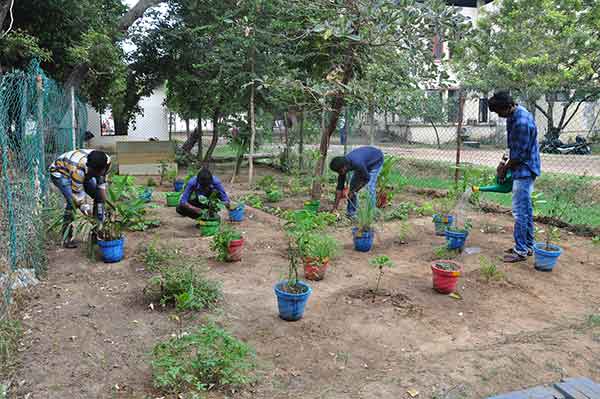
India has rich diversity of more than 10,000 medicinal plants. Over the centuries, people in India have a fascination and respect for the natural heritage, traditional plant ethics, and herbal medicine. This wealth of traditional herbal knowledge is diminishing with the advancement of modern medicine. A significant part of knowledge and tradition is currently being eroded due to modernization, urbanization, shrinking of forest resources and availability of alternatives. However, these valuable traditional practices are still followed in interior tribal areas of India. According to World Health Organization (WHO), more than 80% of the world’s population relies on traditional medicines for their primary health care needs. Therefore it is important to inculcate the young minds to realize the fascinating knowledge and tradition, associated with these resources and help them understand the immense potential for the future.
In view of the above reason, the Department of Biotechnology, Hindustan College of Arts & Science established an herbal garden on 15-02-2018 to popularize the use of commonly available medicinal plants and also encourage the student to pursue research on the same. Department of Biotechnology is responsible for the maintenance of the Herbal Garden with the active involvement of the Enviro-club volunteers. The development of the herbal garden is taken care of by the staff in charge, Dr. T. Ramesh. The herbal garden contains 10 rare and 30 common medicinal plants.
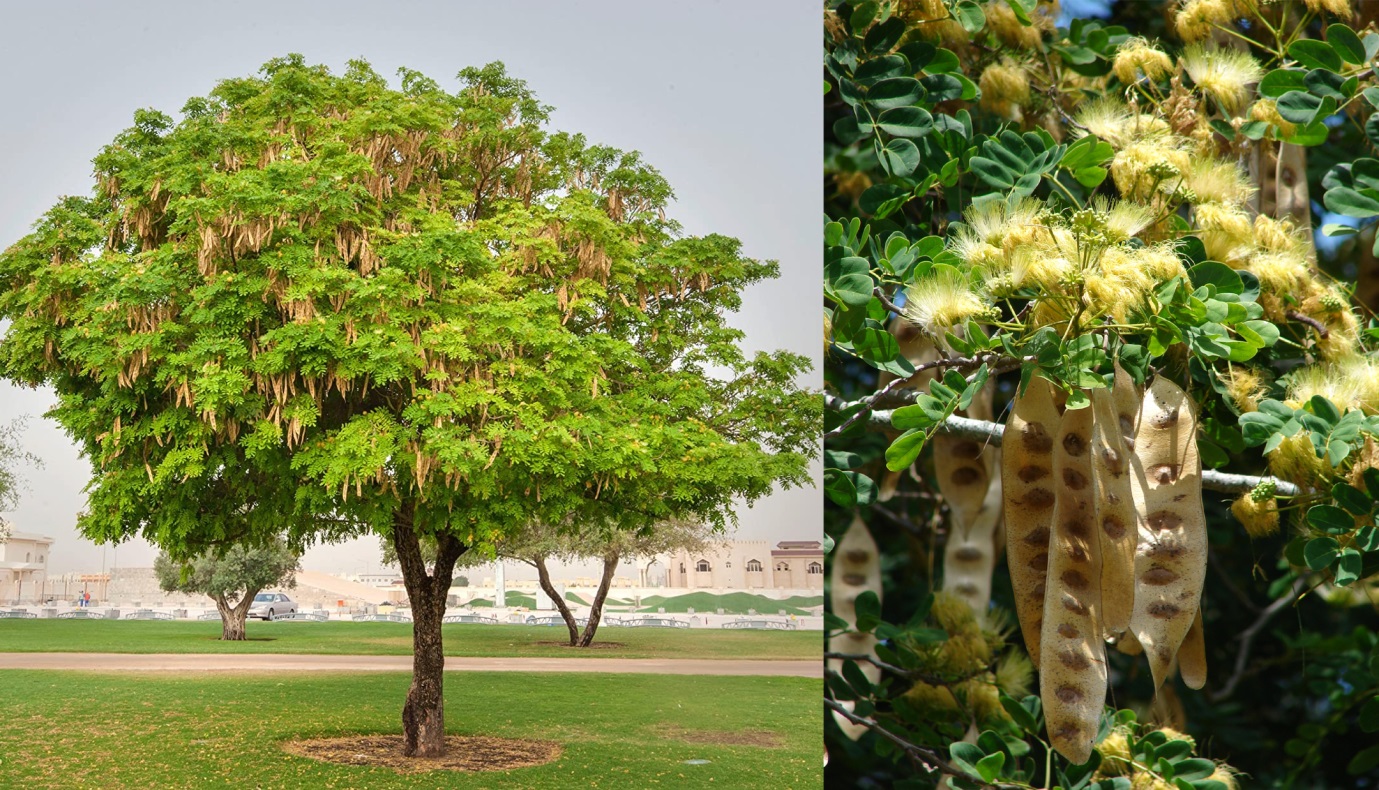
Botanical Name: Albizia lebbeck
Kingdom: Plantae
Family: Fabaceae
Genus: Albizia
Species: A. lebbeck
Location: Native to Indo-Malaya, Northern Australia and New Guinea. It is widely cultivated in other tropical and subtropical regions.
Description: Albizia lebbeck is a tree with a height of 18-30m tall and the leaves are long up to 15cm having four pairs of pinnae and it consists of six to eight leaflets in each pinnae. The flower of this tree is white in colour and contains long stamens along with a pleasant fragrance. There are 6-12 seeds in the fruit of a pod which as 2.5-5cm broad and 15-30cm long.
Medicinal Uses: Bark of this tree is used medicinally to treat inflammation and also acts as a psychoactive. Also, it can aid to treat boils, cough, gingivitis, abdominal tumors, eye, flu, lung problems, and pectoral problems.
References: Ali, S.I. (1973): Albizia lebbeck (L.) Benth.. In: Flora of Pakistan (Vol. 36: Mimosaceae). University of Karachi, Karachi. HTML fulltext Brown, Sandra (1997): Appendix 1 - List of wood densities for tree species from tropical America, Africa, and Asia. In: Estimating Biomass and Biomass Change of Tropical Forests: a Primer. FAO Forestry Papers 134. ISBN 92-5-103955-0 HTML fulltext Schetini de Azevedo, Cristiano; Penha Tinoco, Herlandes; Bosco Ferraz, João & Young, Robert John (2006): The fishing rhea: a new food item in the diet of wild greater rheas (Rhea americana, Rheidae, Aves). Revista Brasileira de Ornitologia 14(3): 285-287 [English with Portuguese abstract]. PDF fulltext United States Department of Agriculture (USDA) (1994): Germplasm Resources Information Network - Albizia lebbeck (L.) Benth.. Version of 1994-AUG-23. Retrieved 2008-MAR-30.
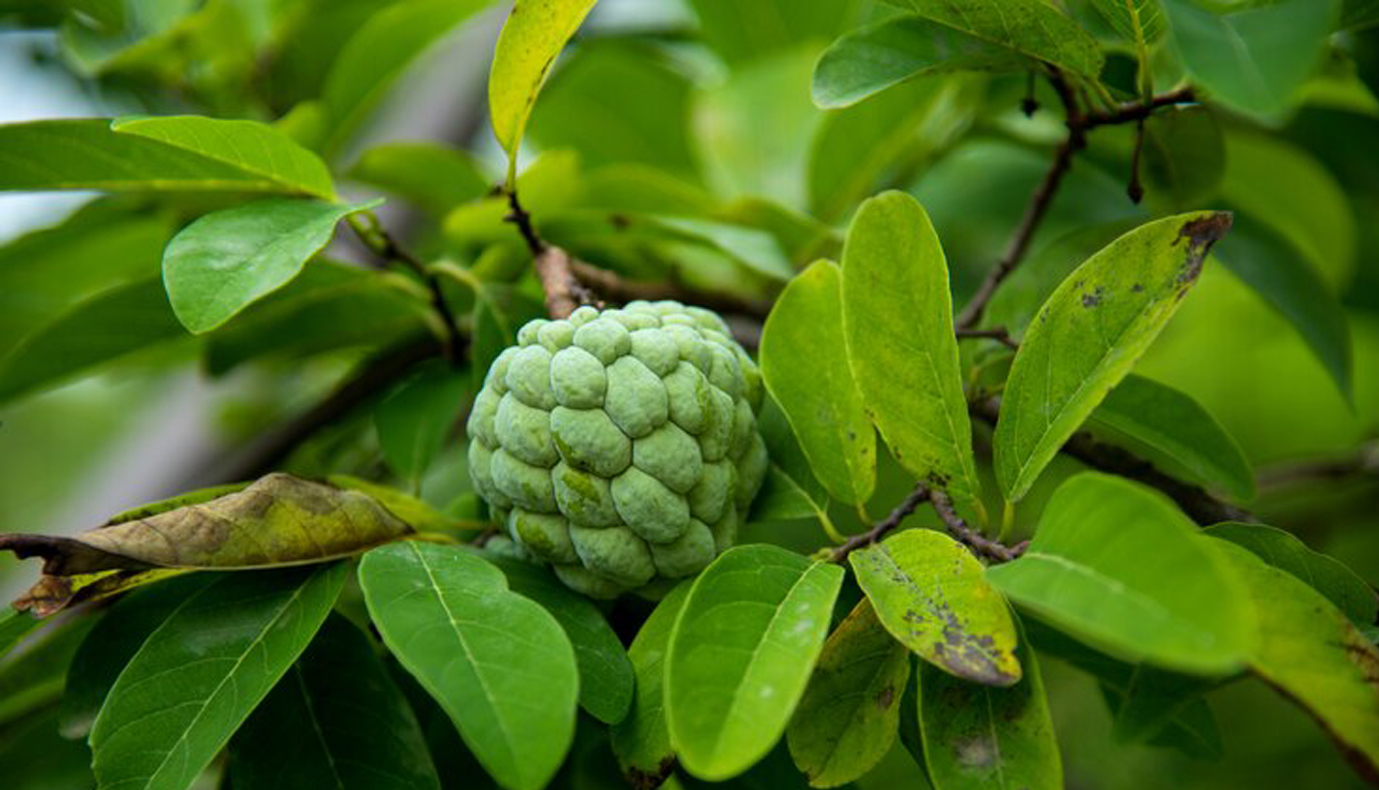
Botanical Name: Annona squamosa
Kingdom: Plantae
Family: Annonacceae
Genus: Annona
Species:A. squamosa
Location: Native to West India and tropical America. It is widely cultivated in china, Indonesia, Thailand, Taiwan. But the exact origin is unknown.
Description: It is a shrub or small tree in 3m to 8m tall. The fruit shape varies in spherical, heart-shaped and irregular which is composed of knobby segments with a weight of 100-240g. The pulp is white tinged yellow, edible and sweetly aromatic. The seeds of this fruit are 1.3cm to 1.6cm long. Flowering occurs in spring-early summer and the flowers are pollinated by nitidulid beetles.
Medicinal Uses: In Thailand and American medicine, the leaves were used to treat urinary tract infection & dysentery. In Indian traditional medicine, the leaves were crushed and applied to wounds. The crude extract of parts and pure isolated phytoconstituents of this fruit was reported to acquire anti-diabetic, antiviral, antioxidant activity, respiratory stimulant, during pregnancy and diuretics properties, very useful for the improvement of immune system, nervous system and also for the development of brain in the fetus.
References: "Current name: Annona squamosa". AgroForestryTree Database. International Center For Research In Agroforestry. Archived from the original on 2011-05-26. Retrieved 2008-04-17. "Compilation: Annona squamosa". Global Plants. JSTOR. Retrieved 2019-09-05. Kral, Robert. "Annona squamosa Linnaeus, Sp. Pl. 1: 537. 1753". In Flora of North America Editorial Committee (ed.). Flora of North America North of Mexico. Vol. 3. Retrieved 2019-09-05. McGregor, S.E. Insect Pollination Of Cultivated Crop Plants USDA, 1976
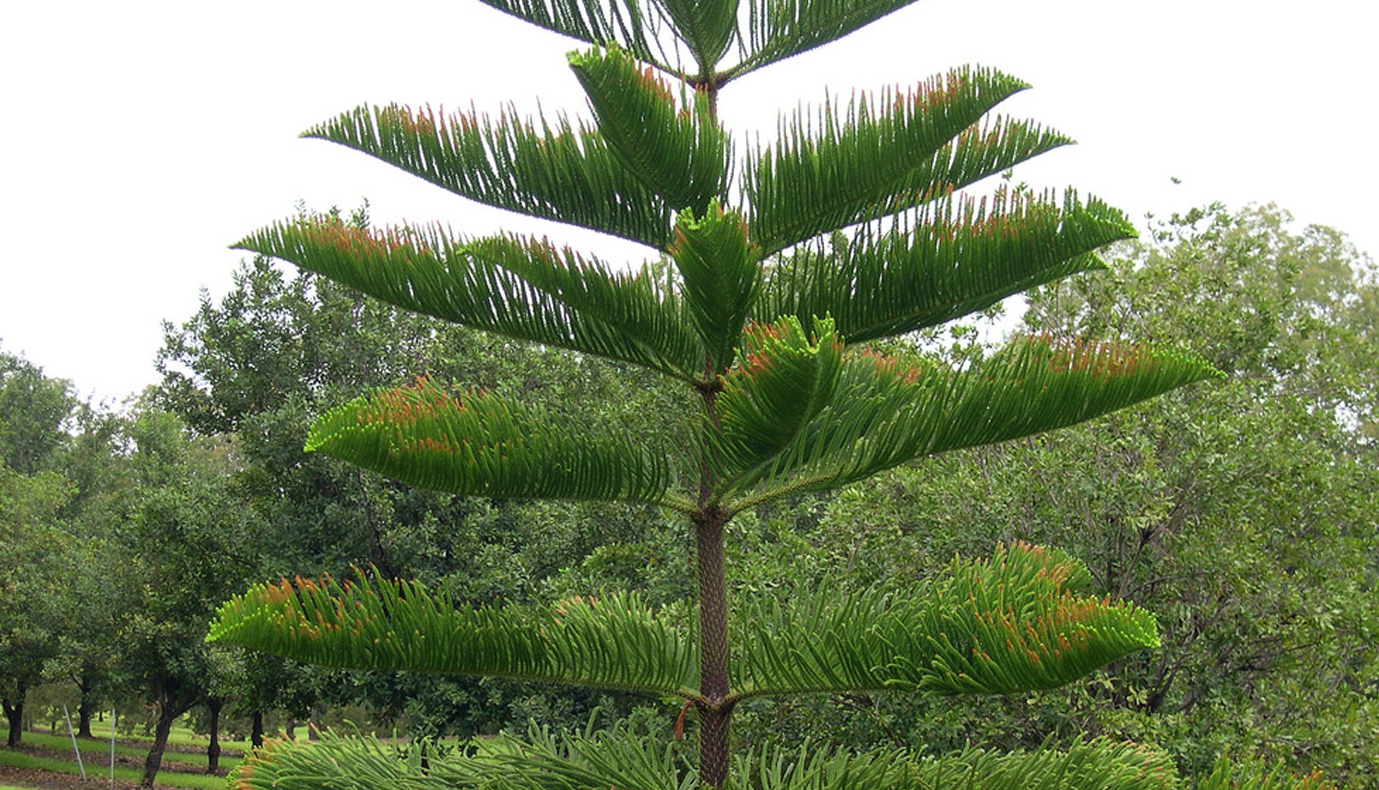
Botanical Name: Araucaria heterophylla
Kingdom: Plantae
Family: Araucariaceae
Genus: Araucaria
Species:Araucaria heterophylla
Location: Araucariaceae, native to Norfolk Island, situated in the South Pacific Ocean between New Caledonia and New Zealand.
Description: It is a slow growing tree, reaching a height of 50–65 m (160–210 ft), with straight vertical trunks and symmetrical branches, even in the face of incessant onshore winds that can contort most other species. From the straight trunk, it emits its branches almost horizontal or slightly oblique, in number of five, forming floors; the plane of each floor is a perfect pentagon. If kept indoors, the tree remains smaller. The gray-brown bark falls off in fine scales. At the more or less horizontal to sometimes hanging branches, the branches are four to seven in regular whorls.
Medicinal Uses: Resin isolated from stem exudates showed anti-ulcerogenic activity against ethanol-induced stomach ulcers in Sprague Dawley rats using ranitidine as standard. Araucaria leaves has the potential for a cheap and efficient bio sorbent for toxic hexavalent chromium removal from natural and waste waters. A. heterophylla leaf powder can be used as an effective, low cost, and environmentally friendly bio sorbent.
References: https://www.cabi.org/isc/datasheet/7155
https://www.britannica.com/plant/Norfolk-Islandpine#:~:text=Norfolk%20Island%20pine%2C%20(Araucaria%20heterophylla,construction% 2C%20furniture%2C%20and%20shipbuilding.
http://www.stuartxchange.org/NorfolkPine.html

Botanical Name: Araucaria heterophylla
Kingdom: Plantae
Family: Meliaceae
Genus: Azadirachta
Species:Azadirachta indica
Location: Neem is likely native to the Indian subcontinent and to dry areas throughout South Asia.
Description: Neem trees can reach 15–30 meters (49–98 feet) in height and have attractive rounded crowns and thick furrowed bark. The compound leaves have toothed leaflets and are typically evergreen but do drop during periods of extreme drought. The small fragrant white flowers are bisexual or staminate (male) and are borne in clusters in the axils of the leaves. The fruit is a smooth yellow-green drupe and has a sweet-flavored pulp.
Medicinal Uses: Neem leaf is used for leprosy, eye disorders, bloody nose, intestinal worms, stomach upset, loss of appetite, skin ulcers, diseases of the heart and blood vessels (cardiovascular disease), fever, diabetes, gum disease (gingivitis), and liver problems. The leaf is also used for birth control and to cause abortions. The bark is used for malaria. The seed and seed oil are used for leprosy and intestinal worms. The seed and seed oil are used for leprosy and intestinal worms. The flower is used for reducing bile, controlling phlegm, and treating intestinal worms.
References: https://en.wikipedia.org/wiki/Azadirachta_indica
https://www.jocpr.com/articles/herbal-remedies-of-azadirachta-indica-and-its-medicinalapplication.pdf
https://www.britannica.com/plant/neem-tree
https://www.rxlist.com/neem/supplements.htm#:~:text=Neem%20leaf%20is%20used%20for,control%20and%20to%20cause%20abortions.

Botanical Name: Bambusa vulgaris
Kingdom: Plantae
Family: Poaceae
Genus: Bambusa
Species:Bambusa vulgaris
Location: Bamboos grow from sea level, in the tropics, to 4000 meters above sea level, in the temperate region. Cambodia, China, Laos, Myanmar, Thailand, Vietnam.
Description: Bambusa vulgaris culms are bright green, glossy, erect below and arching above and have an average height between 10-20 m. Nodes are prominent, of which the lower ones often with a narrow ring of roots and covered with brown hairs.
Medicinal Uses: Bamboo plants play a significant role in traditional Asian medicine, especially in China and Japan. It give protection against oxidative stress. It prevents Inflammation, Lipotoxicity, Cancer and Cardiovascular disease. Bamboo extract can leave the skin with perfect strength and firmness, which makes it perfect for acne-prone skin.
References: https://www.biologydiscussion.com/economic-botany/bamboos/bamboos-in-india-history-habitat-and-uses/52834
https://www.guaduabamboo.com/blog/bambusa-vulgaris
https://www.ncbi.nlm.nih.gov/pmc/articles/PMC4659479/
https://www.google.com/amp/s/indianexpress.com/article/lifestyle/life-style/korean-skincare-beauty-benefits-of-bamboo-6334736/lite/
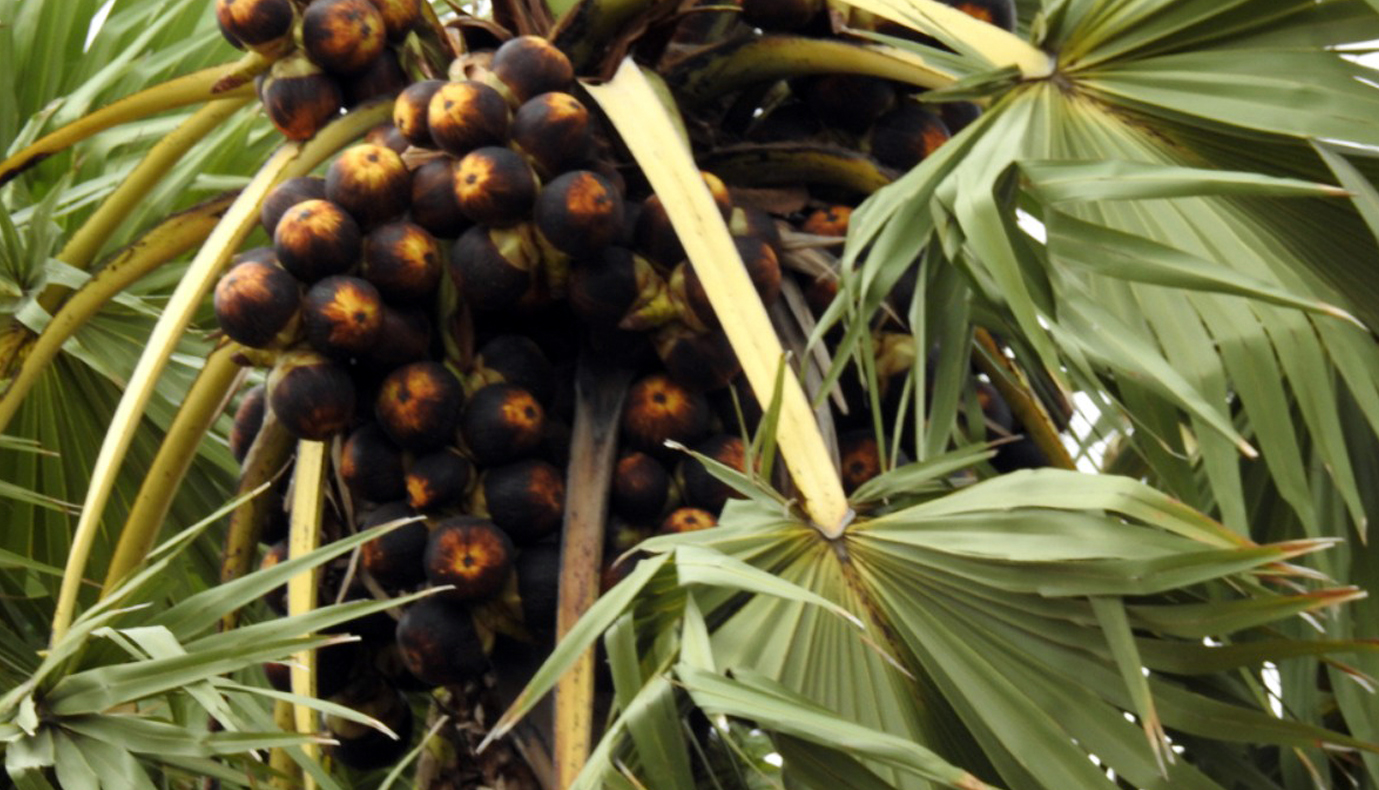
Botanical Name: Borassus flabellifer L.
Kingdom: Plantae
Family: Arecaceae
Genus: Borassus
Species:B. flabellifer
Location: Palmyra plant is a native of tropical Africa but cultivated and naturalized throughout India.
Description: Borassus flabellifer is a robust tree and can reach a height of 30m. The trunk is grey, robust and ringed with leaf scars old leave remain attached to the trunk for several years before falling cleanly. The fruits are black to brown with sweet, fibrous pulp and each seed is enclosed within a woody endocarp.
Medicinal Uses: Different parts of this plant have biological activities and pharmacological functions, including anthelmintic, diuretic, antioxidant and antibacterial activities of the fruits, wound healing, immunomodulatory, and even antimalarial properties. The fruits of the tree found to be cold, laxative, anthelmintic and sedative.
References:
http://www.flowersofindia.net/catalog/slides/Palmyra%20Palm.html
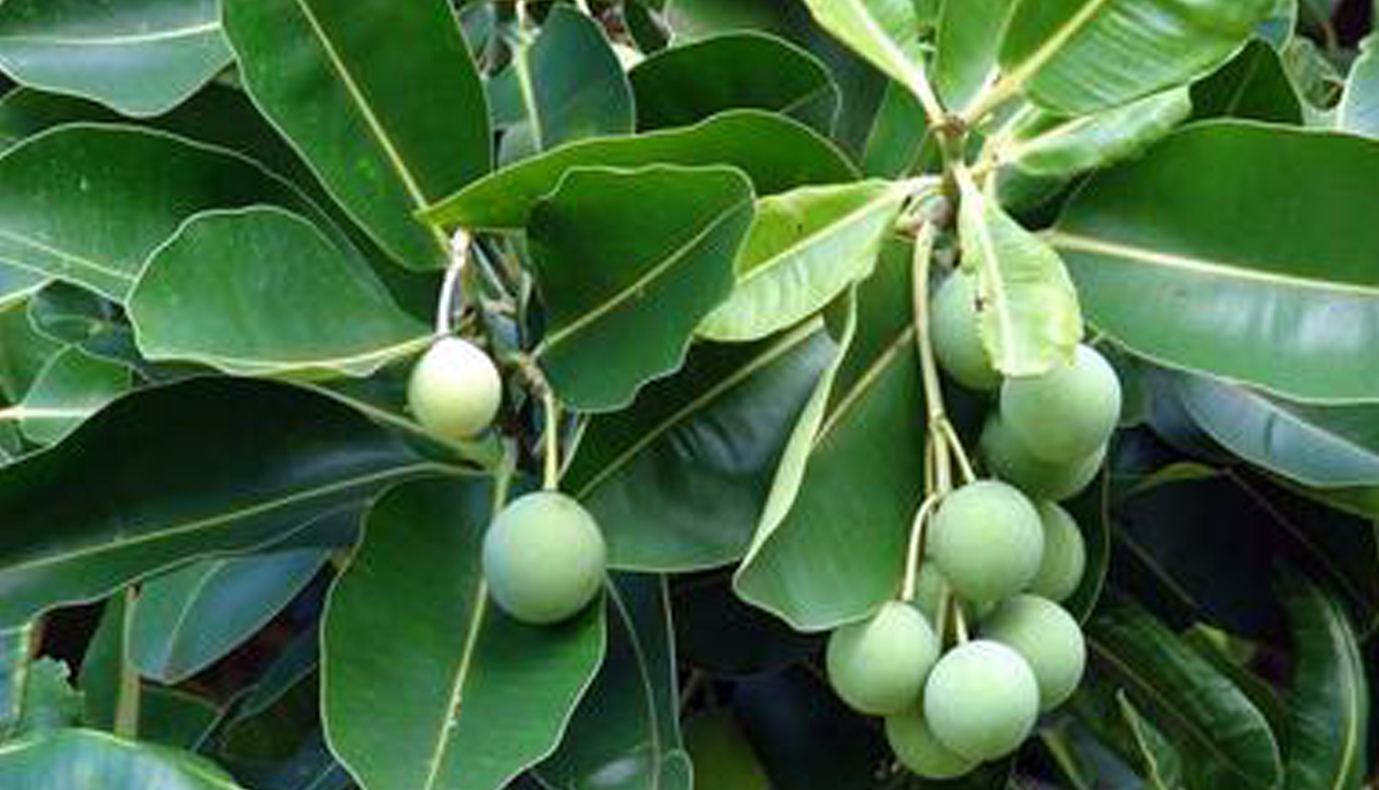
Botanical Name: Calophyllum inophyllum L.
Kingdom: Plantae
Family: Calophyllaceae
Genus: Calophyllum
Species:C. inophyllum
Location: Punnai is widely grown above the high tide mark along sea coasts of northern Australia and extending throughout Southeast Asia and southern India.
Description: Punnai is low branching and slow growing tree with a broad and irregular crown. It usually reaches 8 to 20m (26 to66 ft) in height. The flower is 25mm wide and occurs in racemose or paniculate inflorescences consisting of 4 to 15 flowers. The fruit (the ball nut) is a round, green drupe measuring 2 to 4cm (0.79 to 1.57) in diameter and having single large seed. When ripe, the fruit is wrinkled and its color varies from yellow to brownish red.
Medicinal Uses: Punnai is commonly used in various areas where it occurs where it occurs coumarins isolated from the leaves and seeds have been shown to be inhibitors of HIV type 1. Seed extract shows significant molluscicidal activity. The ether extract of the leaves showed piscicidal activity. A root decoctin is traditionally used to treat ulcer, boils and opthalmia. The bark is used to treat orchitis. The latex is rubbed on the skin in the treatment of rheumatism and psoriasis. The flowers are used as a heart tonic.
References: https://en.wikipedia.org/wiki/Calophyllum_inophyllum
http://tropical.theferns.info/viewtropical.php?id=Calophyllum+inophyllum
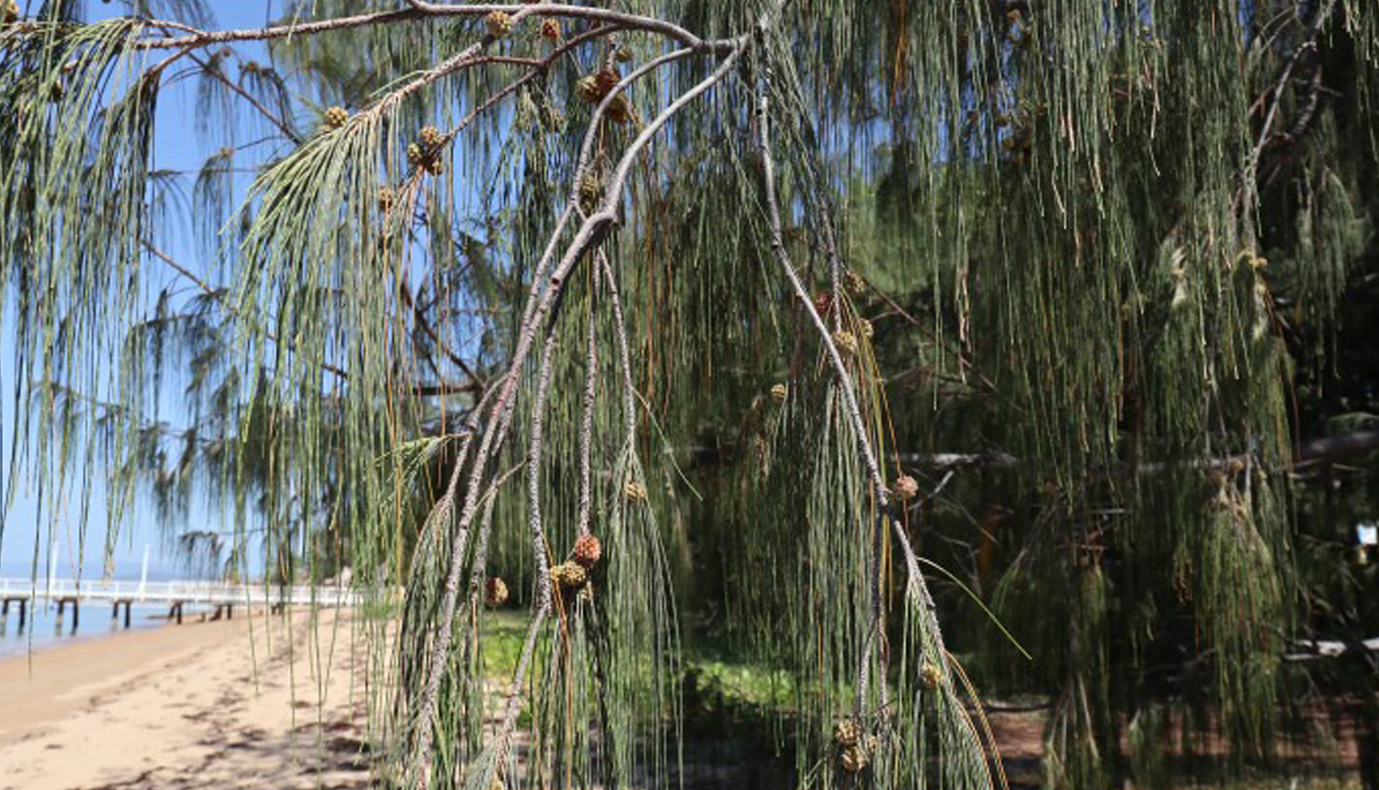
Botanical Name: Casuarina equisetifolia
Kingdom: Plantae
Family: Casuarinaceae
Genus: Casuarina
Species:C. equisetifolia
Location: Native range extends throughout Southeast Asia, Northern Australia and pacific islands. Populations are also found in Madagascar, but it is doubtful if this is within the native range of the species.
Description: Casuarina is an evergreen tree growing to 6 to 35m (20 to115ft) tall. The foliage consists of slender, much branched green to grey-green twigs 0.5-1mm (0.020-0.039) in diameter, bearing minute scale-leaves in whorls of 6-8. The flowers are produced in small catkin- like inflorescence; the male flowers in simple spikes 0.7-4cm (0.28-1.57) in long , the female flowers on short peduncles. The fruit is oval woody structure 10-24mm (0.39-0.94) in long and 9-13 (0.35-0.51) in diameter, superficially resembling a conifer cone made up of numerous carpals each containing a single seed with a small wing 6-8mm (0.24-0.31) in long.
Medicinal Uses: The bark has been used for tanning and still occasionally used by amateur tanners. Medicinal use is made of the roots to treat dysentery, diarrhea and stomach ache. In west Malaysia, a decoction of the twigs is used for treating swellings and the powdered bark is used for treating facial pimples.
References: https://en.wikipedia.org/wiki/Casuarina_equisetifolia
https://uses.plantnet-project.org

Botanical Name: Delonix regia
Kingdom: Plantae
Family: Fabales
Genus: Delonix
Species:D. regia
Location: Delonixregia, commonly called flamboyant or royal poinciana, is a tropical tree that is native to madagascar but has been widely planted around the world in tropical and semi-tropical areas.
Description: The flowers of delonixregia are larger, with four spreading scarlet or orange red petals up to 8cm (3in) long and a fifth upright petal called standard. The pods are green and flaccid when young and turn dark-brown and woody, which is slightly larger and spotted with yellow and white. The seeds are small, weighing around 0.4 grams (6.2 grains) on average.
Medicinal Uses: Delonixregia leaves provide forage for livestock and the seed meal can be fed to farm animals. The flowers are the good and profuse source of feed for bees. The bark is useful in ethno-medicine and the leaves and flower have been reported to have herbicide. The wood ash of delonixregia could significantly reduce several fungi and insects.
References: https://powo.science.kew.org/taxon/urn:lsid:ipni.org:names:491231-1
https://indiabiodiversity.org/species/show/264753
 Pax & K.Hoffm..jpg)
Botanical Name: Drypetes sepiaria (Wight & Arn.) Pax & K.Hoffm.
Kingdom: Plantae
Family: Putranjivaceae
Genus: Drypetes
Species:D. sepiaria
Location: Drypetes sepiaria is a species of small tree in family Putranjivaceae. This tree is very common in India and Sri Lanka.
Description: Inflorescence flowers are bracteolate axillary clusters or short racemes. The fruits are crimson in color, small sphere in shape and fusi-form drupe. The trunk are often gnarled, twisted or flutes, rigid, much-branched.
Medicinal Uses: This plant is used in folk medicine by the tribal people of Western Ghats treat pain and inflammation. The seeds of this plant are used as a wild edible food by Palliyars (tribal group) of Western Ghats.
References: https://indiabiodiversity.org/species/show/246024
https://www.gbif.org/species/3075936

Botanical Name: Ficus benghalensis
Kingdom: Moraceae
Family: Rosales
Genus: Plantae
Species:F. subg. Urostigma
Location: Found mainly in monsoon and rain forests
Description: The giant banyans of India are the largest trees in the world by area of canopy coverage. The largest, known specimen of tree in the world in terms of the two dimensional area covered by its canopy is Thimmamma Marrimanuin Andhra Pradesh, India, which covers 19,107 square metres (205,670sqft). This tree is also the largest, known specimen of tree in the world in terms of the length of its perimeter, which measures 846 meters (2,776ft).
Medicinal Uses: Ficus benghalensis, also known as Indian Banyan tree It has exceptional medicinal property which helped in curing various life- threatening diseases. The ancient medicine systems such as Ayurveda, Siddha, Unani and Homeopathy were using this tree extensively to as medicine for various diseases. Various parts of these trees were used to cure many deadly diseases such as dysentery, diarrhea, diabetes leucorrhoea, menorrhagia, nervous disorders, tonic and astringent.
References: FicusbenghalensisLinn-TheSacredIndianMedicinalTreewithPotentPharmacological Remedie
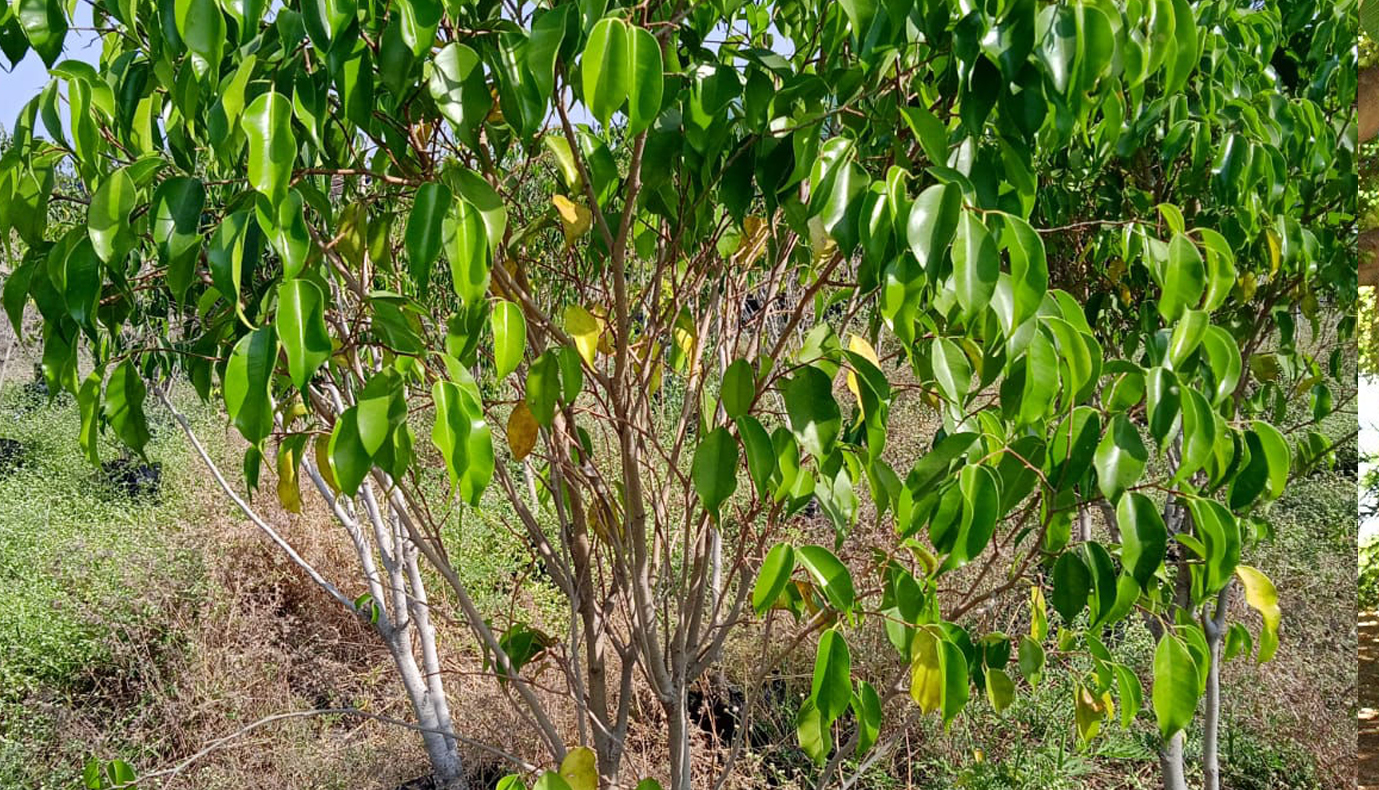
Botanical Name: Ficus benghalensis
Kingdom: Moraceae
Family: Rosales
Genus: Plantae
Species:Ficeae
Location: Native to Asia and Australia.
Description: Ficus benjamina is a tree reaching 30m (98 feet) tall in natural conditions, with gracefully drooping branch lets and glossy leaves 6-13 cm (2+31a-5+11a inches), oval with an acuminate tip. The bark is light gray and smooth. The bark of young branches is brownish. The widely spread, highly branching tree top often covers a diameter of 10 meters. It is a relatively small-leaved fig.
Medicinal Uses: Its latex and some fruit extracts are used by indigenous communities to treat skin disorders, inflammation, piles, vomiting, leprosy, malaria, nose-diseases and cancer besides the use as a general tonic. The plant is also used as antimicrobial, antinociceptive, antipyretic, hypotensive and anti-dysentery remedy. All examined extracts and fractions were significantly rich in antioxidants and exhibited potent antimicrobial activity. GC/MS analysis of essential oil identified four compounds in stem and eight compounds in root, respectively. HPLC analysis indicated four phenolic compounds (chlorogenic, p-coumaric, ferulic and syringic acids) in roots, three (chlorogenic p – coumaric and ferulic acids) in stem and only one (caffeic acid) in leaves. Extracts of all three parts of F. benjamina exhibited substantial hemolytic activity.
References: https://en.m.wikipedia.org/wiki/Ficus_benjamina
https://www.ncbi.nlm.nih.gov/pmc/articles/PMC4015825/Chemicalcomposition andBiologicalstudiesofFicusbenjamina
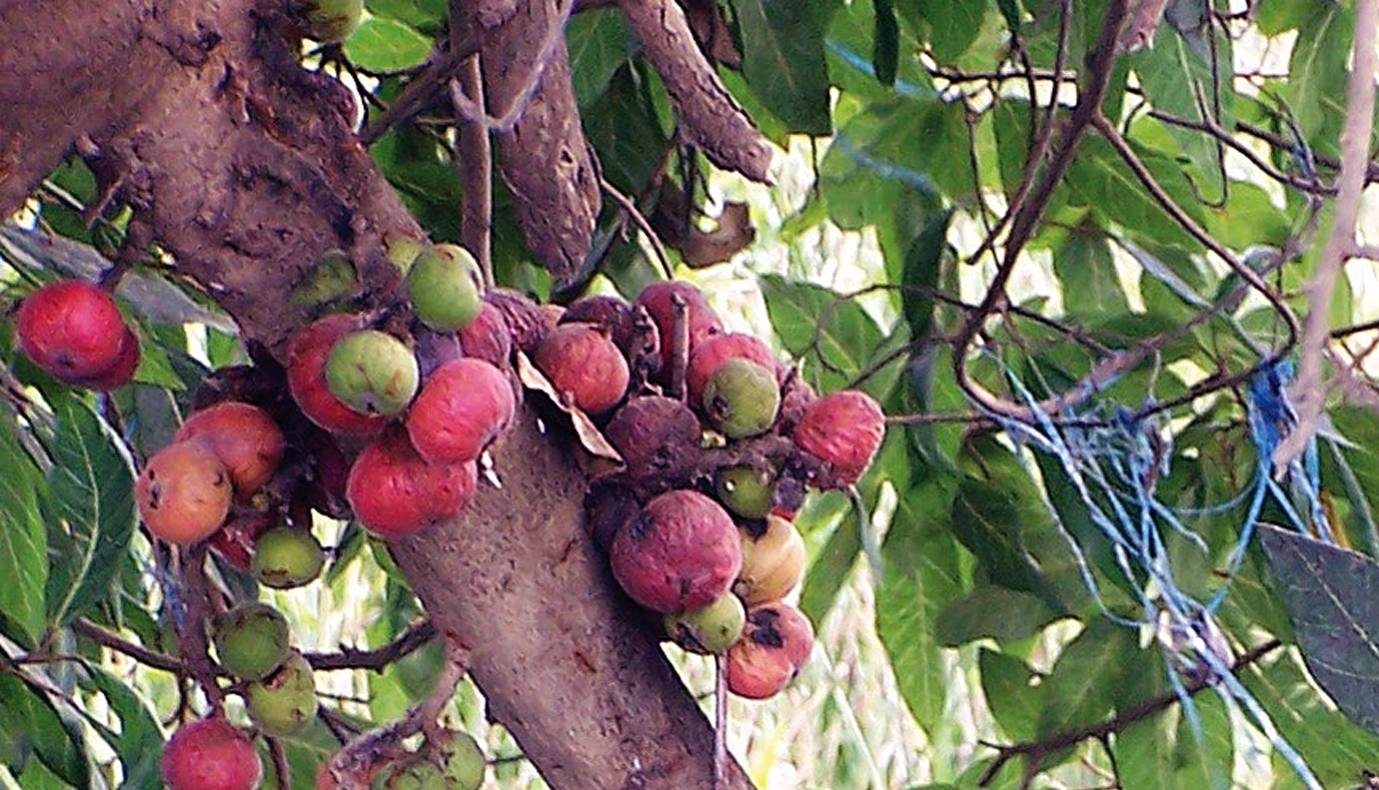
Botanical Name: Ficus racemosa
Kingdom: Plantae
Family: Moraceae
Genus: Ficus
Species:F. racemosa
Location: Ficus racemosa is widely grown in Australia and tropical Asia.
Description: Cluster fid is an evergreen or, in drier areas, deciduous tree, often with an irregular crown; it can be grown 20-30 meters tall. The bole becomes deeply buttressed as the tree grows older and can be 36-90cm in diameter. The tree is harvested from the wild for local use as a food and medicine. It is often cultivated, both for its fruit and also as a shade tree in plantations and an ornamental tree in parks, large gardens etc.
Medicinal Uses: The leaves are used in the treatment of diarrheal. The bark is astringent. It is used in the treatment of haematuria, menorrhagia and haemoptysis. The fruit, when filled with sugar, is considered to be very cooling. A fluid that exudes from the cut roots of the tree is considered to be powerful tonic when drunk for several days together. The sap is a popular remedy in Bombay, that is applied locally to mumps and together inflammatory glandular enlargements, and is also used in the treatment of gonorrhoea. The root is chewed as a treatment for tonsillitis.
References: https://en.m.wikipedia.org/wiki/ficus-racemosa tropical plants database, ken fern-tropical.theferens.info

Botanical Name: Ficus religiosa
Kingdom: Plantae
Family: Moraceae
Genus: Ficus
Species:F. religiosa
Location: Peepal trees are native to Indian subcontinent and thrive in hot, humid weather. Peepal tree in the ancient city of Anuradhapura in Sri Lanka
Description: Ficus religiosa is a large dry season deciduous or semi evergreen tree up to 30 metres (98 ft) tall and with a trunk diameter of up to 3 metres (9.8 ft). The leaves are cordate in shape with a distinctive extended drip tip; they are 10-17cm (3.9-6.7in) long and 8-12cm (3.1-4.7in) broad, with a 6-10cm (2.4-3.9in) petiole. The fruits are small figs 1-1.5cm (0.39-0.59in) in diameter, green ripening to purple. Average life span of Ficus religiosa between 900 and 1500 years
Medicinal Uses: The leaves and twigs are alternative, antidote, aphrodisiac, astringent, antigonorrhoeal and laxative. It is used as an antidote against bites of venomous animals, and for the treatment of haemoptysis and fistula. Fresh sap from the leaves is used to cure diarrhoea, cholera and for wound healing. An infusion of the bark is drunk as an antidiabetic. A decoction of the bark is used as skin wash to treat scabies, ulcer and skin diseases. The aerial roots are diuretic. They are used in the treatment of ascites and are chewed by women to promote fertility. The fruit is laxative.
References: https://en.m.wikipedia.org/wiki/ficus-religiosa
https://tropical.theferns.info/ficus-religiosa
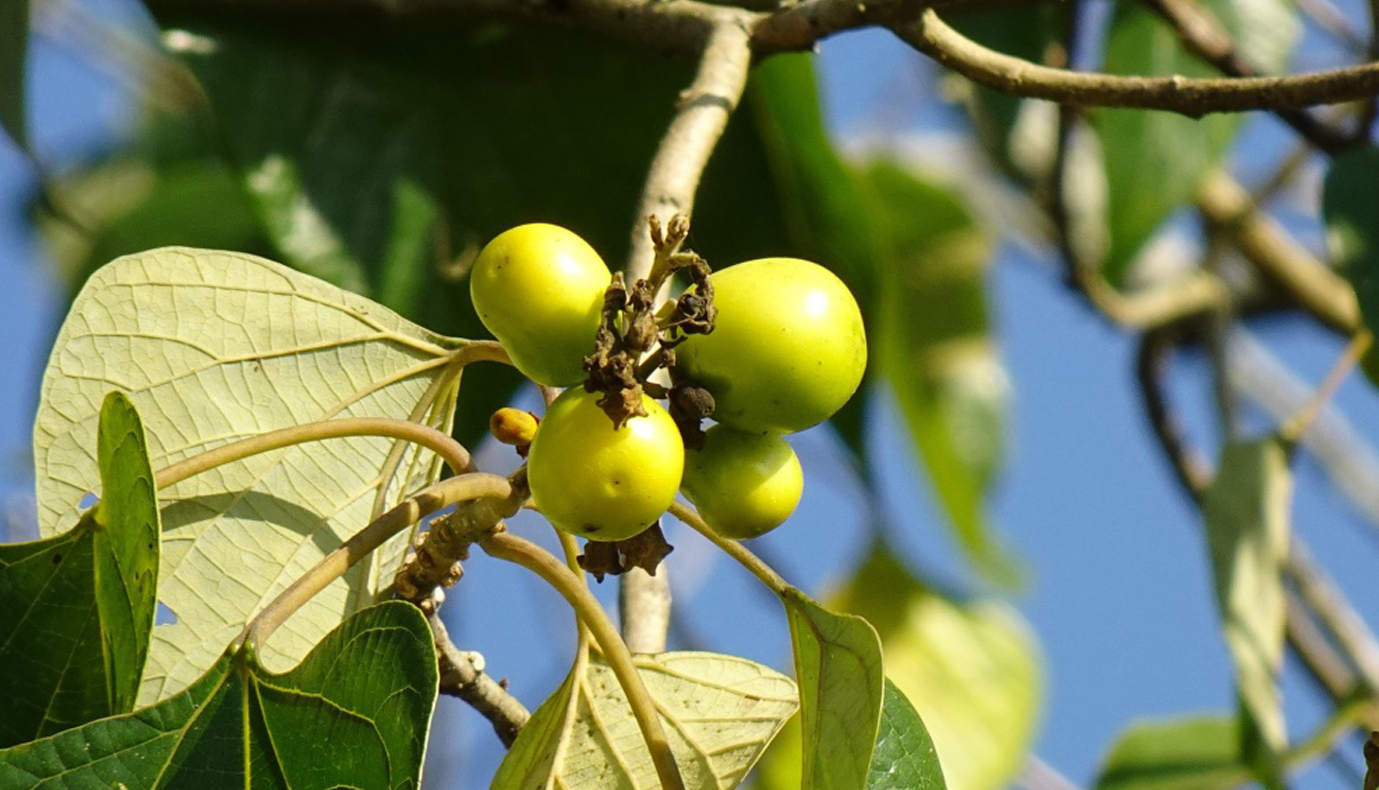
Botanical Name: Gmelina arborea Roxb
Kingdom: Plantae
Family: Lamiaceae
Genus: Gmelina
Species:G. arborea
Location: Gmelina arborea grows naturally throughout India, Myanmar, Thailand, Laos, Cambodia, Vietnam and in southern provinces of China.
Description: Gmelina arborea is an unarmed, moderately sized to large deciduous tree with a straight trunk. It is wide spreading with numerous branches forming a large shady crown, attains a height of 30 m or more and a diameter of up to 4.5 m.
Medicinal Uses: The whole plant is used in medicine. It is astringent, bitter, digestive, cardio tonic, diuretic, laxative and pulmonary and nervine tonic. It improves digestion, memory, helps overcome giddiness and is useful in burning sensation, fever, thirst, emaciation, heart diseases, nervous disorders and piles.
References: https://pubmed.ncbi.nlm.nih.gov/33217516/
http://www.worldagroforestry.org
https://en.wikipedia.org/wiki/Gmelina_arborea
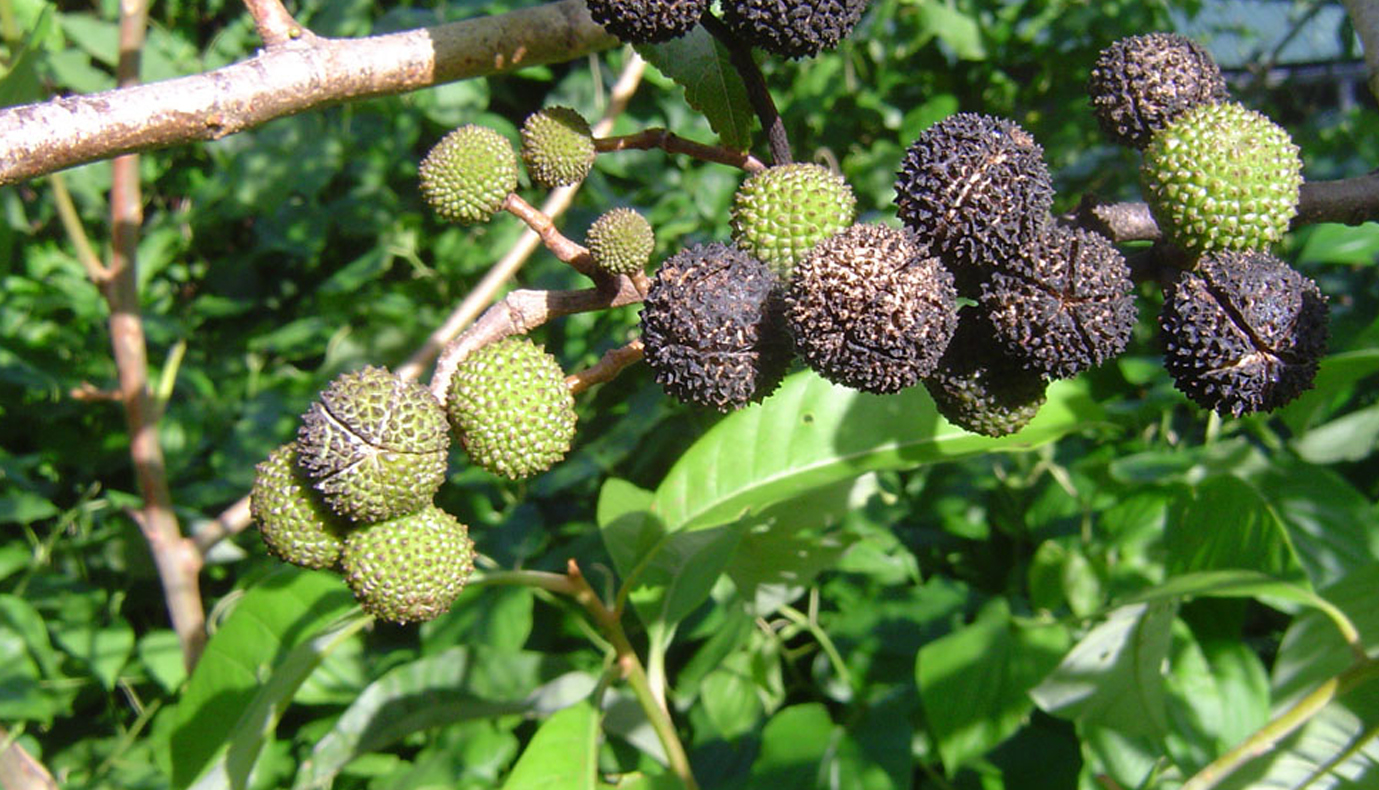
Botanical Name: Guazuma ulmifolia
Kingdom: Plantae
Family: Malvaceae
Genus: Guazuma
Species:G. ulmifolia
Location: It is widely found in areas such as the Caribbean, South America, Central America and Mexico.
Description: Guazuma ulmifolia, commonly known as West Indian elm or bay cedar, is a medium-sized tree normally found in pastures and disturbed forests. This flowering plant from the family Malvaceae grows up to 30m in height and 30–40cm in diameter.
Medicinal Uses: In traditional medicine, the bark of Guazuma ulmifolia is used in the treatment of diarrhea, hemorrhages, fever, coughs, bronchitis, asthma, gastrointestinal pain and hypertension, and as stimulant for uterine contractions.
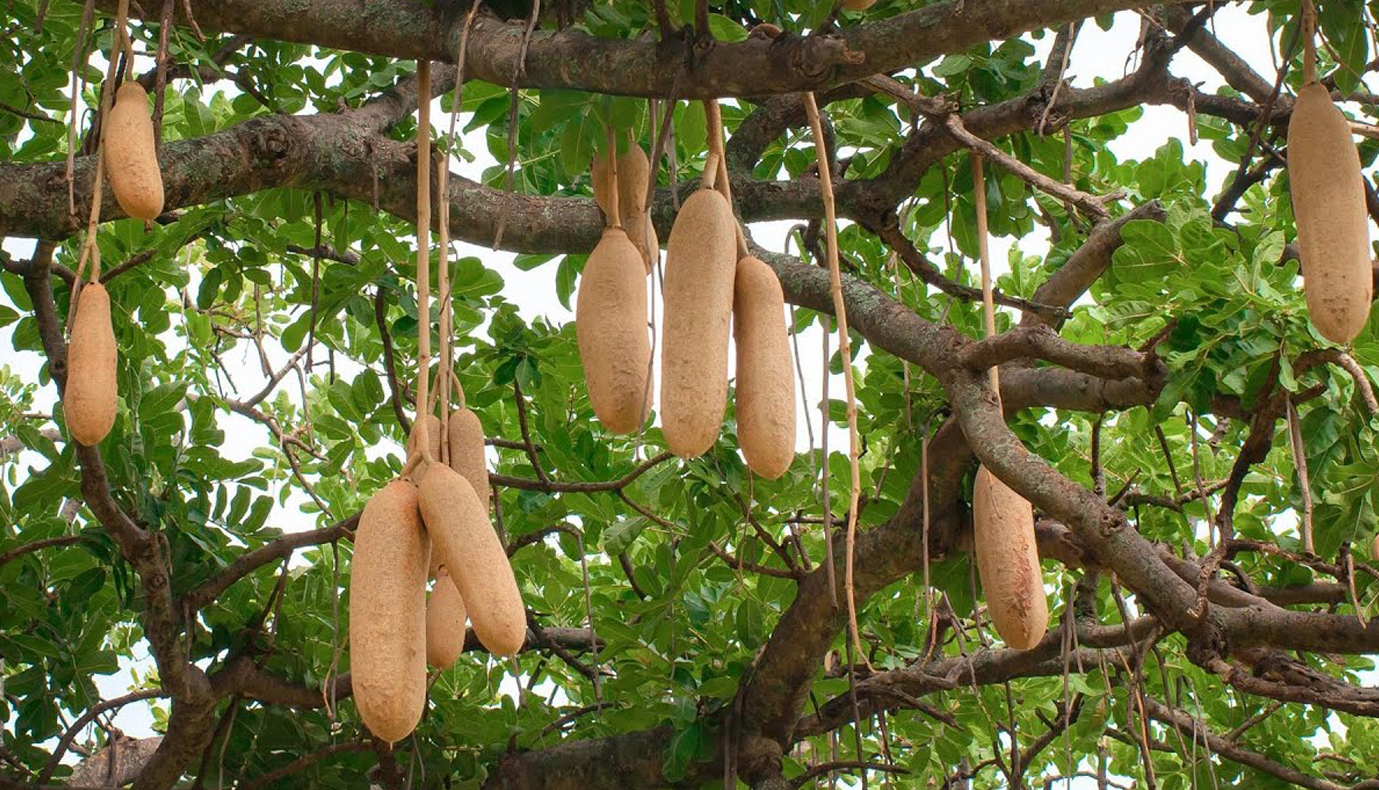
Botanical Name: Guazuma ulmifolia
Kingdom: Plantae
Family: Bignoniaceae
Genus: Kigelia
Species:Kigelia africana
Location: Kigelia africana is native sub-Saharan Africa and South Africa
Description: It is a tree growing up to 20 m tall and typically has spreading branches. The wood is pale brown or yellowish. The fruit pulp is fibrous containing many seeds. Flowers are produced in panicles. The flowers hang down from branches on long flexible stems. Individual flowers do not hang down but are oriented horizontally. The sausage tree grows a poisonous fruit that is up to 60 cm long, weight 7 kg.
Medicinal Uses: It is used to skin care products and high level of antioxidant and anti-inflammatory constituents. The leaves are used to prepare a general tonic for improved health and growth. It is used to treat digestive disorders.
References: http://en.m.wikipedia.org
http://uses.plantet-project.org
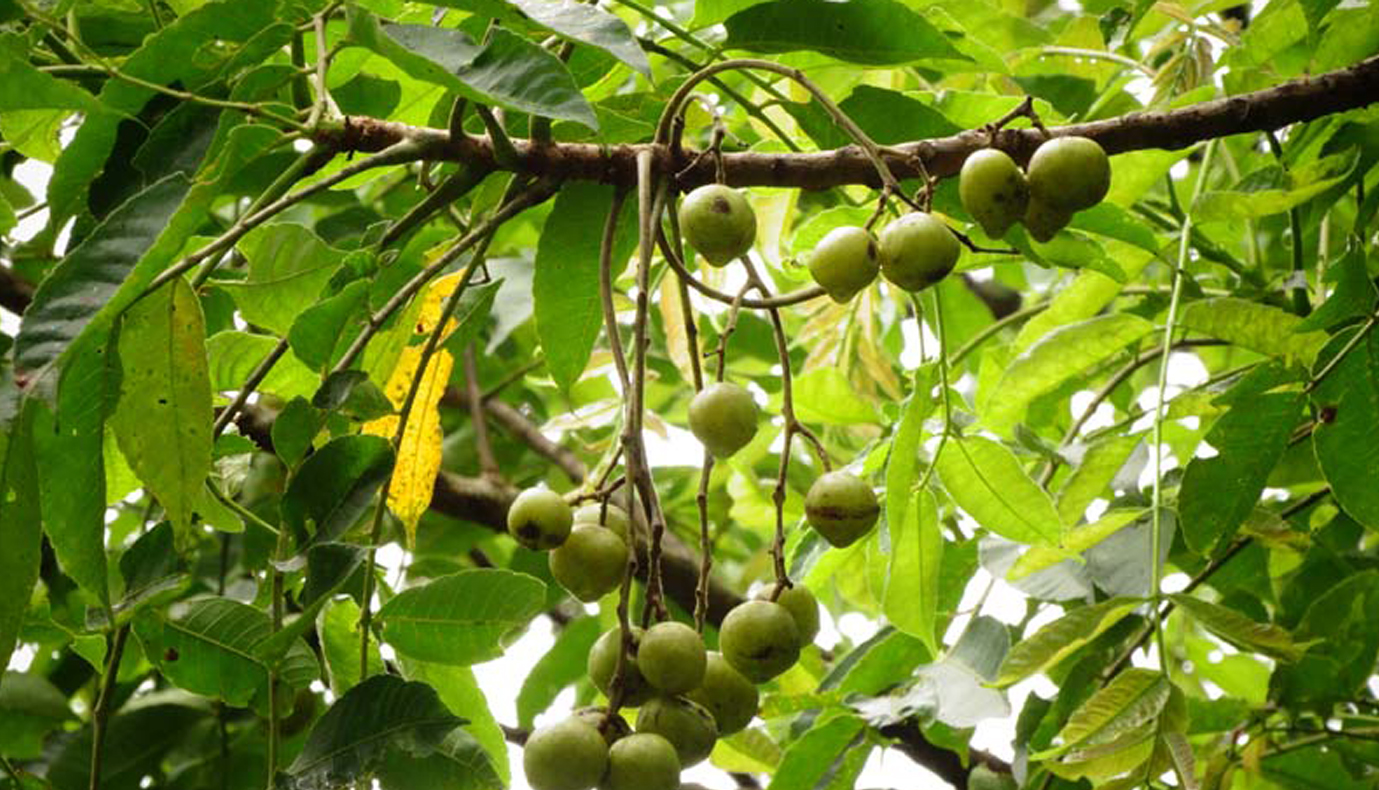
Botanical Name: Lannea coromandelica (Houtt.) Merr.
Kingdom: Plantae
Family: Anacardiaceae
Genus: Lannea
Species:Lannea coromandelica
Location: Lannea coromandelica, family Anacardiaceae that grows in south east Asia ranging from srilanka to southern china
Description: Indian ash tree is deciduous tree growing up to 14m tall. Its leaves arranged are pinnate with a single terminate leaflet at end. Leaflets are up to 7cm long. Flowers are unisexual, greenish, male in compound and female in simple racemes the end of leafless branches. Sepals 4, about 1mm long. Petals 4, 2mm long green yellow. Flowering: January- March.
Medicinal Uses: Lannae coromandelica used in Ayurveda and Ancient system of medicine for the treatment inflammation, cholera, vaginal troubles etc. Its revealed antiflammtory, antimicrobial, hypotensive and anti cancerous activities. It is used folk medicine. Leaves, bark, stem, and gum used to treat an assortment of diseases.
References: http://www.flowersofindia. Net/catalog/slides/indian%20Ash%20Tree.html
http://ijpsr.com/bft article/detection-of-active-constitvents-from-the-leaf-extracxct-of-lannae coromandelica-by-gc-testing-and-assements-of-its –pharmacological-activity/?">

Botanical Name: Lawsonia inermis
Kingdom: Plantae
Family: Lythraceae
Genus: Lawsonia
Species:inermis
Location: The henna plant is native to northern Africa, Asia and northern Australia, in semi-arid zones and tropical areas.
Description: Henna is a tall shrub or small tree, standing 1.8 to 7.6 m tall (6 to 25 ft). It is glabrous and multi-branched, with spine-tipped branchlets. The leaves grow opposite each other on the stem. They are glabrous, sub-sessile, elliptical, and lanceolate (long and wider in the middle; average dimensions are 1.5–5.0 cm x 0.5–2 cm or 0.6–2 in x 0.2–0.8 in), acuminate (tapering to a long point), and have depressed veins on the dorsal surface. Henna flowers have four sepals and a 2 mm (0.079 in) calyx tube, with 3 mm (0.12 in) spread lobes. Its petals are ovate, with white or red stamens found in pairs on the rim of the calyx tube. The ovary is four-celled, 5 mm (0.20 in) long, and erect. Henna fruits are small, brownish capsules, 4–8 mm (0.16–0.31 in) in diameter, with 32–49 seeds per fruit, and open irregularly into four splits.
Medicinal Uses: It is the source of the dye henna used to dye skin, hair and fingernails, as well as fabrics including silk, wool and leather. Medicinal properties include the cure of renal lithiases, jaundice, wound healing; prevent skin inflammation. The bark is traditionally used in treatment of jaundice and enlargement of the spleen, renal calculus, leprosy and obstinate skin diseases.
References: Ali M, Grever MR:. A cytotoxic napthoquinone from Lawsonia inermis. Fitoterapia.1998; 69(2):181-183. Endrini S, Rahmat A, Ismail P, Taufiq-Yap YH.: Comparing of the cytotoxicityproperties and mechanism of Lawsonia inermis and Strobilanthes crispus extract againstseveral cancer cell lines. J Med Sci. 2007; 7(7):1098-1102. Munshi SR, Shetye TA, Nair RK: Antifertility activity of three indigenous plantpreparations. Planta Med. 1977; 31:73-75. Singh S, Shrivastava NM, Modi NT, Saifi AQ: Anti-inflammatory activity of Lawsoniainermis. Current Science (Bangalore). 1982; 51:470-471.

Botanical Name: Mangifera indica
Kingdom: Plantae
Family: Anacardiaceae
Genus: Mangifera
Species:M. indica
Location: Mango is widely grown in north-western Myanmar, Bangladesh, and India.
Description: It is a long green tree; it is valued for its fruit which are both green and ripe. It can grow upto 15-30 meters (49-98 ft) tall mangos are irregular, egg-shaped fruit which have fleshy part inside it. They are typically 8-12 cm long and greenish color. Its flowers appear in red-yellow color. It has both male and female flowers which are born on same tree. It grows best in well-drains sandy loam. It does not grow well in heavy wet soils.
Medicinal Uses: Mango fruits contain pre-biotic dietary fibre, vitamins, minerals and poly-phenolic flavonoid. It is a very good source of vitamin-A and flavonoids (beta-carotene, alpha-cartone and beta-crypto-xanthin), fresh mango is a very source of potassium and, it has vitamin-B6 (pyridoxine) which is required for GABA hormone production in brain. Vitamin C and E helps body develop resistance against infectious agents and scavenge harmful oxygen free radicals. It has copper which is required to produce red blood cells.
References: https://www.cabi.org/isc/datasheet/34505>
http://publish.plantnet-project.org/plantinvasivekruger/collection/synthese/details/MNGI
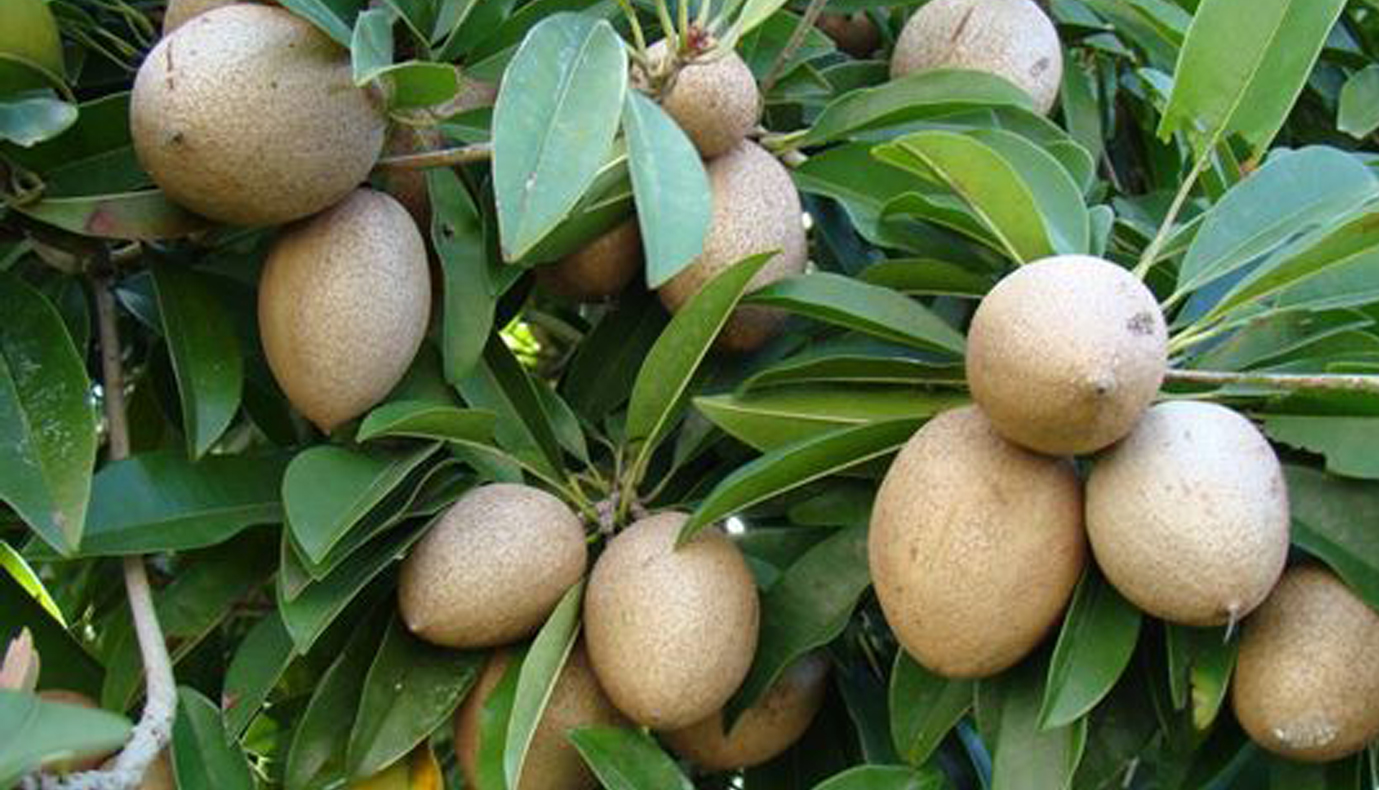
Botanical Name: Manilkara zapota
Kingdom: Plantae
Family: Sapotaceae
Genus: Manilkara
Species:M. zapota
Location: Zapota is widely grown in southern Mexico, Central America and the Caribbean and Spanish civilization it is introduced in India, Pakistan, Thailand, Malaysia, Cambodia, Indonesia, Vietnam, Bangladesh and Mexico.
Description: Zapota can grow to more than 30m (98ft) tall with average trunk diameter of 1.5m (Sft) it is wind resistance, and the bark is rich in a white, gummy latex called chicle. They have white flowers are in conspicuous and bell like with a six –lobed corolla an unripe fruit has firm outer skin it releases chicle when picked a fully ripened fruit has saggy skin and does not release chicle when picked. Fruit is a large berry 4-8 cm it fleshes range from a pale yellow to an earthy brown color with a grainy texture skin. Each fruit contains one to six seeds. The seeds are hard, glossy and black resembling beans. The fruit has an exceptionally sweet, malty flavor.
Medicinal Uses: They are rich in phyto-chemicals and antioxidants. The fruit is rich in vitamins, carbohydrates, minerals and it is a good source of energy and contains flavonoid and bioactive polyphenolic compounds. Natural antioxidants can assist in the protection of human cells against the effects of free radicals that may contribute to cancer forming cells among other diseases. The fruit is used to prevent diarrhea, the crushed seeds were used to prevent kidney stone. While the leaves decoction was consumed to treat fever, hemorrhage, wounds, and ulcers.
References: https://www.scielo.br/j/bjps/a/BQFH3BtGBLs7t9kwsvzvfLH/?format=pdf&lang=en
https://www.tandfonline.com/doi/full/10.1080/15538362.2019.1687071
https://en.wikipedia.org/wiki/Manilkara zapota

Botanical Name: Melia azedarach
Kingdom: Plantae
Family: Meliaceae
Genus: Melia
Species:M. azedarach
Location: Melia azedarach is native to Southeast Asia and northern Australia. It was introduced into the United States in the mid 1800s for ornamental purposes.
Description: The fully grown tree has a rounded crown, and commonly measures 7–12 metres (20–40 ft) tall, however in exceptional circumstances M. azedarach can attain a height of 45 metres (150 ft). The leaves are up to 50 centimeters (20 in) long, alternate, long-petioled, two or three times compound (odd-pinnate); the leaflets are dark green above and lighter green below, with serrate margins. The flowers are small and fragrant, with five pale purple or lilac petals, growing in clusters. The fruit is a drupe, marble-sized, light yellow at maturity, hanging on the tree all winter, and gradually becoming wrinkled and almost white. As the stem ages and grows, changes occur that transform its surface into bark.
Medicinal Uses: Melia azedarach is used as an ayurvedic medicine in India and Unani medicine in Arab countries as an antioxidative, analgesic, anti-Inflammatory, insecticidal, rodenticidal, antidiarrhoeal, deobstruent, diuretic, antidiabetic, cathartic, emetic, antirheumatic and antihypertensive.
References: https://en.M.Wikipedia.org/wiki/Melia_azedarach
https://www.flowersofindia.net/catalog/slides /persian %20lilac.html
https:/www.cabi./orgisc/datasheet/33144

Botanical Name: Mimusops elengi
Kingdom: Plantae
Family: Sapotaceae
Genus: Mimusops
Species:elengi
Location: The plant is native to South and Southeast Asia, particularly the coastal areas of the Indian subcontinent, Bangladesh, Sri Lanka, Vietnam and Myanmar, as well as Northern Australia. It was introduced in China in the 20th century, and it is now cultivated in its south, as well as in Taiwan.
Description: Bullet wood is an evergreen tree reaching a height of about 16 m (52 ft). It flowers in April, and fruiting occurs between June and October. The leaves are glossy, dark green, oval-shaped, 5–14 cm (2.0–5.5 in) long, and 2.5–6 cm (0.98–2.36 in) wide. The flowers are cream, hairy, and scented. The fruits are fleshy, range in color between yellow and brown, and contain a large brown seed. The pulp has a yellow color and it is edible. The bark of the tree is thick and appears dark brownish black or grayish black in colour, with striations and a few cracks on the surface. The tree may reach up to a height of 9–18 m (30–59 ft) with about 1 m (3 ft 3 in) in circumference.
Medicinal Uses: The bark, flowers, fruits, and seeds of Bakula are used in Ayurvedic medicine in which it is purported to be astringent, cooling, anthelmintic, tonic, and febrifuge. It is mainly used for dental ailments such as bleeding gums, pyorrhea, dental caries, and loose teeth.
References: Rajkumara S, Pandiselvi A, Sandhiya G. Isolation of Chemical Constituents from Mimusops elengi bark and Evaluation of Anti-inflammatory activity. Int J Phytopharmacy. 2012; 3(1): 9-15. Gami B, Parabia MH. Pharmacognostic evaluation of bark and seeds of Mimusops elengi linn. Int J Pharm Pharmaceut Sci. 2010;2(4): 110-113 Gopalkrishnan B, Shimpi SN. Seeds of Mimusops elengi linn. Pharmacognosy and Phytochemistry studies. Int J Pharmacog Phytochem Res. 2010; 3(1): 13-17. Mitra R, Yadav KC. Pharmacognostic study of bakul: mimusops elengi linn. Leaf. Ind J For. 1980; 3: 15-23.
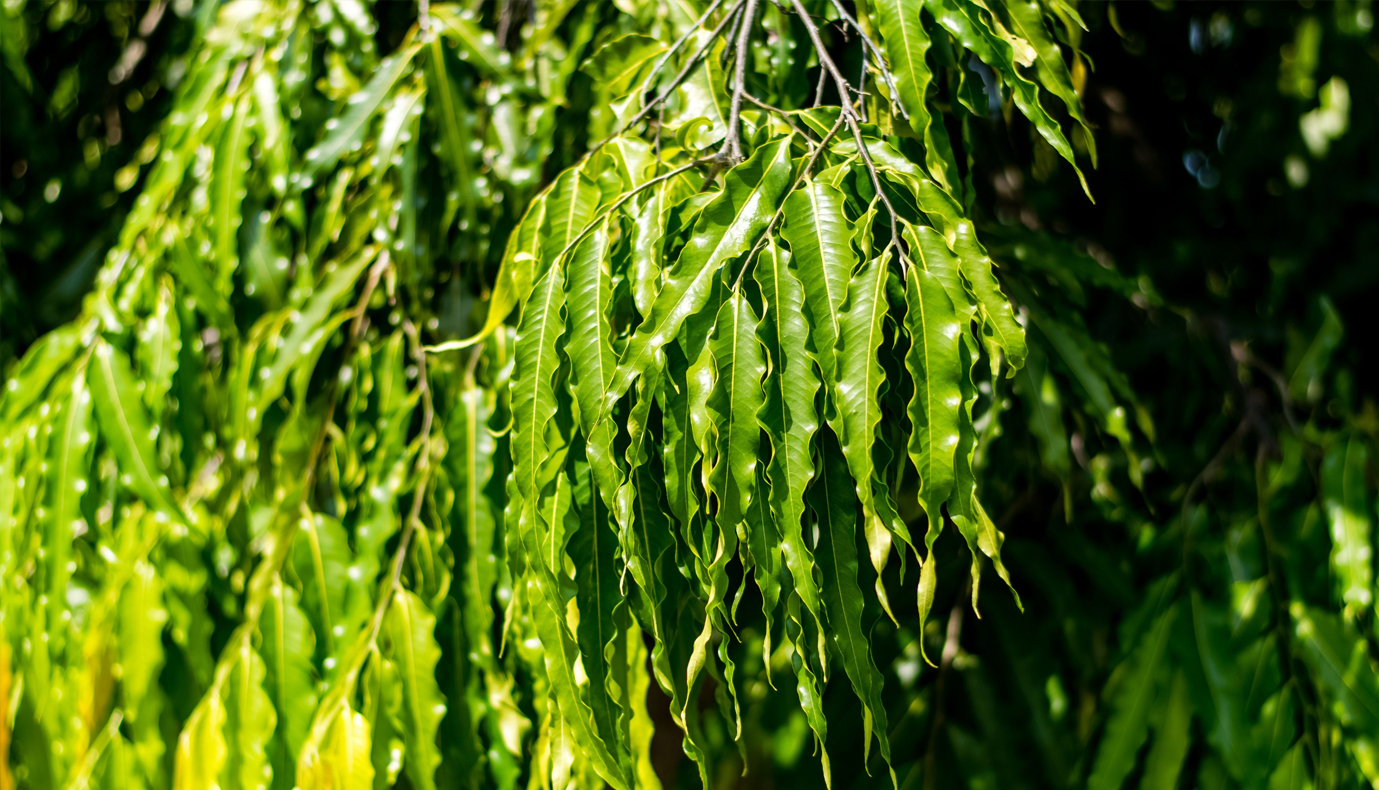
Botanical Name: Monoon longifolium
Kingdom: Plantae
Family: Annonaceae
Genus: Monoon
Species:Monoon longifolium
Location: Found natively in India and Sri Lanka. It is introduced in gardens in many tropical countries around the world. It is, for example, widely used in parts of Jakarta in Indonesia and the Caribbean islands of Trinidad and Tobago.
Description: It exhibits symmetrical pyramidal growth with willowy weeping pendulous branches and long narrow lanceolate leaves with undulate margins. It can reach a height little over 10 meters. Though this tree is specifically pruned in a pyramidal shape, if it is allowed to grow naturally, it can grow into a large, canopied tree
Medicinal Uses: Leaf extracts have anti-bacterial and anti-fungal properties. Bark used in Ayurverdic medicine to treat fever, diabetes, hypertension and intestinal worms. Wood used to make pencils, boxes, matches and drum cylinders. Tall straight trunks used to make masts of sailing ships, hence the common name, Mast Tree.
References: https://en.wikipedia.org/wiki/Monoon_longifolium
http://www.svc.ac.in/SVC_MAIN/Societies/EcoClub/Trees/Monoon%20longifolium.pdf

Botanical Name: Morinda pubescens
Kingdom: Plantae
Family: Rubiaceae
Genus: Morinda
Species:pubescens
Location: Morinda pubescens, commonly known as aal or Indian mulberry, is a species of flowering plant in the family Rubiaceae, native to southern Asia.
Description: Deciduous trees, to 12 m high, bark pale brown, thick, vertically fissured and irregularly cracked; blaze turmeric yellow. Leaves simple, opposite, decussate; stipules interpetiolar, connate, sheathing, bifid at apex; petiole 5-20 mm long, stout, pubescent, grooved above, glabrous; lamina 7.5-25 x 2-8 cm, elliptic-lanceolate, oblanceolate or elliptic-oblong, base acute, cuneate or attenuate, apex acute to acuminate, margin entire, pubescent or tomentose, chartaceous; lateral nerves 7-12 pairs, pinnate, prominent; intercostae reticulate, slender; domatia present. Flowers bisexual, white, in terminal, globose heads; calyx limb truncate; corolla 2 cm long; tube 1 mm long, villous within; lobes 4, oblong, recurved; stamens 4, attached to the throat of corolla; anthers exserted; ovary 1.5 mm, 2-celled or incompletely 4-celled, inferior; style 4 mm; stigma 2 lobed. Fruit a syncarp, 15-18 mm across, globose, pyrenes 4, oblong; seeds not winged.
Medicinal Uses: Morinda pubescens the extract of leaf, root, and fruits of this plant showed anti-bacterial, analgesic, anti-oxidant, anti-inflammatory, astringent, laxative, sedative, and hypotensive (lowers blood pressure) potentials.
References: Baragi VM, Shaw BJ, Renkiewicz RR, Kuipers PJ, Welgus HG, Mathrubutham M, Cohen JR, Rao SK. A versatile assay for gelatinases using succinylated gelatin. Matrix Biol. 2000;19(3):267–273. doi: 10.1016/S0945-053X(00)00086-X. Deepti K, Umadevi P, Vijayalakshmi G. Antimicrobial activity and phytochemical analysis of Morinda tinctoria Roxb leaf extracts. Asian Pac J Trop Biomed. 2012;2(3):S1440–S1442. doi: 10.1016/S2221-1691(12)60433-X. Dons T, Soosairaj S. Evaluation of wound healing effect of herbal lotion in albino rats and its antibacterial activities. Clin Phytosci. 2018;4(1):6. doi: 10.1186/s40816-018-0065-z.

Botanical Name: Murraya koenigii
Kingdom: Plantae
Family: Rutaceae
Genus: Murraya
Species:M. koenigii
Location: The tree is native to the Indian subcontinent. Commercial plantations have been established in India, and more recently Australia. It grows best in well-drained soil that does not dry out, in areas with full sun or partial shade, preferably away from the wind.
Description: Curry leaf tree is a small or medium sized tree, most famous for its aromatic leaves that provide curry spice. Curry leaves and extensively used to southern India and Srilanka (and are absolutely necessary for the authentic flavour). It is a small tree growing 4-6 m tall with a trunk up to 40 cm diameter. The leaves are pinnate with 11-21 leaflets, each leaflet 2-4 cm long and 1-2cm broad. They are highly aromatic. The flower are small white and fragrant. The small black shiny berries are edible, but their seeds and poisonous. Together with south Indian immigrants, curry leaves are generally used fresh off the tree. Outside the Indian sphere an influence. They are rarely found. The yellow ‘’curry powder’’ that is common in western couturiers is actually not curry at all but a mix of spices intended to mimic the true curry flavour. The yellow colour comes from turmeric root.
Medicinal Uses: Leaves are digestive, tonic, stimulant, rich in vitamin A and calcium. Leaves are also used for diarrhoea, dysentry and checking vomitting. Bark-paste is antisceptic, applied to skin eruptions. Root extract is taken for relief from renal pain, The bark is helpful in treating snakebites.
References: http://www.flowersofindia.net/catalog/slides/Curry%20Leaf.html
https://en.m.wikipedia.org/wiki/Curry_tree
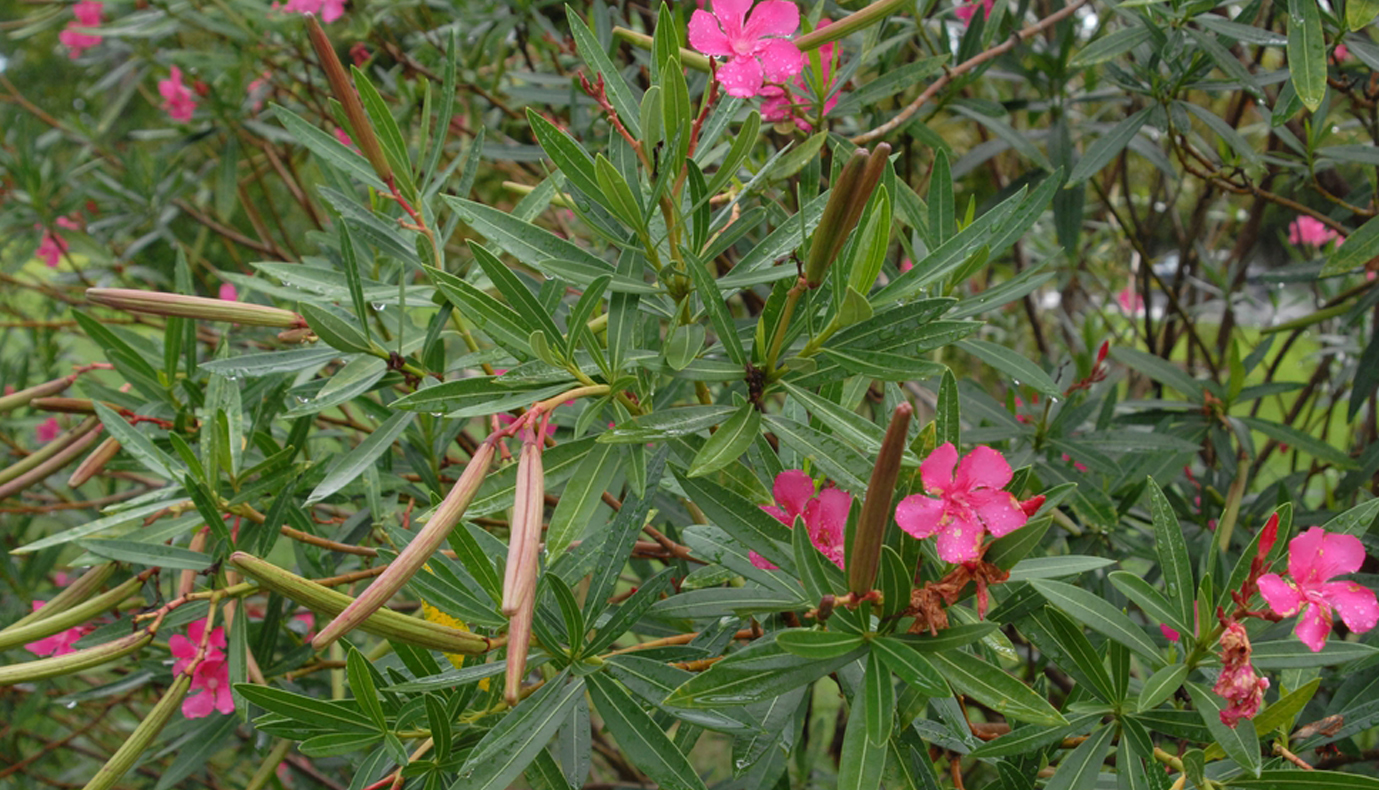
Botanical Name: Nerium oleander
Kingdom: Plantae
Family: Nerium
Genus: oleander
Species:Apocynaceae
Location: Nerium oleander is native to the Mediterranean region, including northern Africa, southern Europe and South East Asia.
Description: Oleander grows to 2–6 m (7–20 ft) tall, with erect stems that splay outward as they mature; first-year stems have a glaucous bloom, while mature stems have a greyish bark. The leaves are in pairs or whorls of three, thick and leathery, dark-green, narrow lanceolate, 5–21 cm (2–8 in) long and 1–3.5 cm (0.39–1.4 in) broad, and with an entire margin filled with minute reticulate venation web typical of eudicots. Leaves are light green and very glossy when young, before maturing to a dull dark green. The flowers grow in clusters at the end of each branch; they are white, pink to red, 2.5 cm (1–2 in) diameter, with a deeply 5-lobed fringed corolla round the central corolla tube. They are often, but not always, sweet-scented. Fruit is a long narrow pair of follicles 5–23 cm (2–9 in) long, which splits open at maturity to release numerous downy seeds. Oleander is one of the most poisonous commonly grown in garden plants.
Medicinal Uses: Despite the danger, oleander seeds and leaves are used to make medicine. Oleander is used for heart conditions, asthma, epilepsy, cancer, painful menstrual periods, leprosy, malaria, ringworm, indigestion, and venereal disease; and to cause abortions, and against snake-bite
References: 1. http://www.flowersofindia.net/catalog/slides/Oleander.html
2. https://www.rxlist.com/oleander/supplements.htm
3. https://en.m.wikipedia.org/wiki/Nerium
 Backer ex K.jpg)
Botanical Name: Peltophorum pterocarpum (DC.) Backer ex K.Heyne
Kingdom: Plantae
Family: Fabaceae
Genus: Peltophorum
Species:Peltophorum pterocarpum
Location: Peltophorum pterocarpum is native to tropical Southeast asia and Australasia, Srilanka, Indonesia, Malaysia, Philippines, Thailand, Vietnam, Papua New Guinea. It is also found in India.
Description: It is a deciduous tree growing to15-25 m tall (rarely up to 50m), with a truck diameter of upto 1m belonging to family leguminosae and subfamily caesalpiniaceaea. The leaves are bipinnate, the flowers are yellow 2.5-4cm in diameter. Pollens are approximately 50 microns in size. The fruit is pod, red at first ripening black and has 1 to 4 seeds. Trees begin to flower after about four years.
Medicinal Uses: Tree is widely grown in tropical regions as an ornamental tree particularly in India, Pakistan, Nigeria. In traditional medicine it is used as an astringent to cure or relieve intestinal disorders after pain at childbirth. It is used for sprains. It is used for swelling or as a lotion for eye troubles. It is used for muscular pains and sores. It is also used for gargles and tooth powders. Leaf decoction is used for skin disorders. An antifungal principle is present in leaflets and buds. An alcoholic extract from the flower has an anti-inflammatory effect and an antibacterial activity.
References: https://en.m.wikipedia.org/wiki/Peltophorum_pterocarpum
http://apps.worldagroforestry.org/treedb/AFTPDFS/Peltophorum_pterocarpum.PDF
https://www.cabi.org/isc/datasheet/39510

Botanical Name: Phyllanthus acidus
Kingdom: Plantae
Family: Phyllanthaceae
Genus: Phyllanthus
Species:acidus
Location: This tropical or subtropical species is found throughout Asia and also in the Caribbean region, Central and South America. In Nicaragua is called as "Grosella". It is also found in Puerto Rico (where the fruit is called grosella), Ecuador, El Salvador, Nicaragua, Mexico, Colombia, Venezuela, Guyana, Suriname (where it's called ronde birambi), US Virgin Islands, Peru and Brazil.
Description: Phyllanthus acidus is an intermediary between a shrub and tree, reaching 2 to 9 m (6½ to 30 ft) high. The tree's dense and bushy crown is composed of thickish, tough main branches, at the end of which are clusters of deciduous, greenish, 15-to-30-cm long branchlets. The branchlets bear alternate leaves that are ovate or lanceolate in form, with short petioles and pointed ends. The leaves are 2–7.5 cm long and thin, they are green and smooth on the upperside and blue-green on the underside. In general, the Otaheite gooseberry tree very much looks like the bilimbi tree.
Medicinal Uses: The plant is also used medicinally. The peppered leaves are used to make a poultice to treat sciatica, lumbago and rheumatism (but have been observed to cause low blood pressure when combined with nitrates), while the seeds are used as a cathartic and the root, if prepared with care, as a purgative. The syrup is used to medicate the stomach, and in India the fruit is eaten as a blood-enhancer for the liver. P. acidus contains 4-hydroxybenzoic acid, caffeic acid, adenosine, kaempferol and hypogallic acid. While the wood is strong and durable if properly treated, the tree is not large and is rarely harvested for wood. In India, the root bark is sometimes used for tanning.
References: Halliwell B 2007 Biochemical Society Transaction 35 1147-1150 Andrianto D, Katayama T and Suzuki T 2015 J Forest Biomass Utilization Society 10 19-25 Habib M R, Sayood M A, Rahman M, Hasan M and Saha A 2011 Int. J. Pharmaceutical Sci. Res. 2 875-881 Chakraboty R, De B, Devanna N and Sen S 2012 Asian Pacific J. Trop. Med. 2 S953-S961
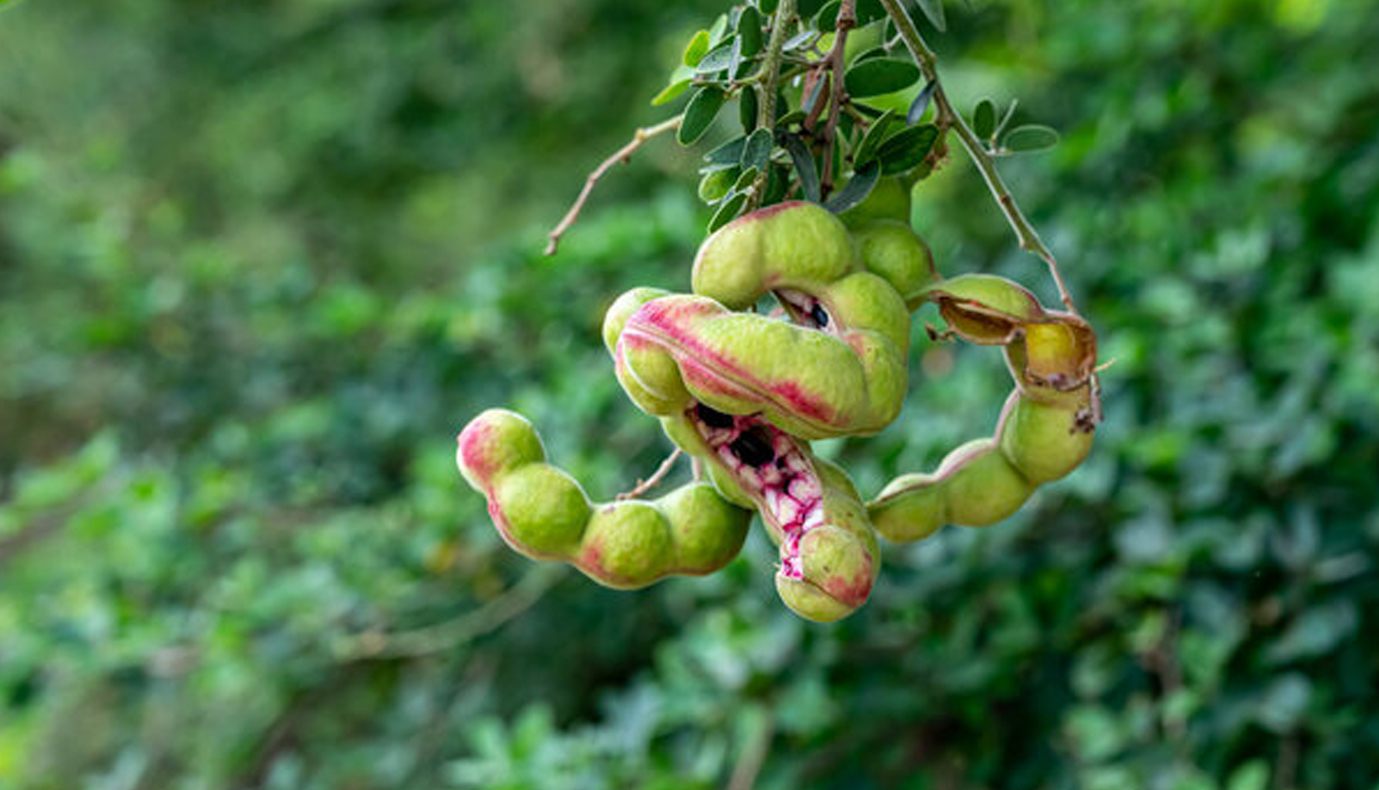
Botanical Name: Pithecellobium dulce (Roxb.) Benth
Kingdom: Plantae
Family: Fabaceae
Genus: Pithecellobium
Species:Pithecellobium dulce
Location: Pithecellobium dulce is native to Tropical America. It is an introduced species in the Caribbean, Florida, Philippines, Guam, Thailand and South Asia.
Description: Pithecellobium dulce is a tree that reaches a height of about 10 to 15 m (33 to 49 ft). Its trunk is spiny and its leaves are bipinnate. Each pinna has a single pair of ovate-oblong leaflets that are about 2 to 4 cm (0.79 to 1.57 in) long. The flowers are greenish-white, fragrant, sessile and reach about 12 cm (4.7 in) in length, though appear shorter due to coiling. The flowers produce a pod, which turns pink when ripe and opens to expose the seed arils; a pink or white, edible pulp. The pulp contains black shiny seeds that are circular and flat. Pollen is a polyad of many pollen grains stitched together.
Medicinal Uses: The bark and pulp being astringent and haemostatic are used to treat gum ailments, toothache and bleeding. Bark extracts are used for chronic diarrhea, dysentery, constipation and tuberculosis. Extract of leaves is employed as a remedy for indigestion and to prevent spontaneous abortion and for gall bladder ailments and to treat both open and closed wounds. Ground seed is used for treating ulcers. Studies also shows that it might help in curing diabetes, inflammation, cancer, tuberculosis, venereal diseases, bilious disorders, fever, cold, sore throat, malaria, skin pigmentation, acne and pimples, dark spots, conjunctivitis, irritable bowel syndrome, pain, eczema, pan ophthalmitis, leprosy. Studies have evaluated its antioxidant, anti-hyperlipidemic, anti-septic, anti-bacterial properties.
References: Rahima Kulsar M. Potential health benefits of manila tamarind. J Med Plants Stud 2019;7(6):167-170.
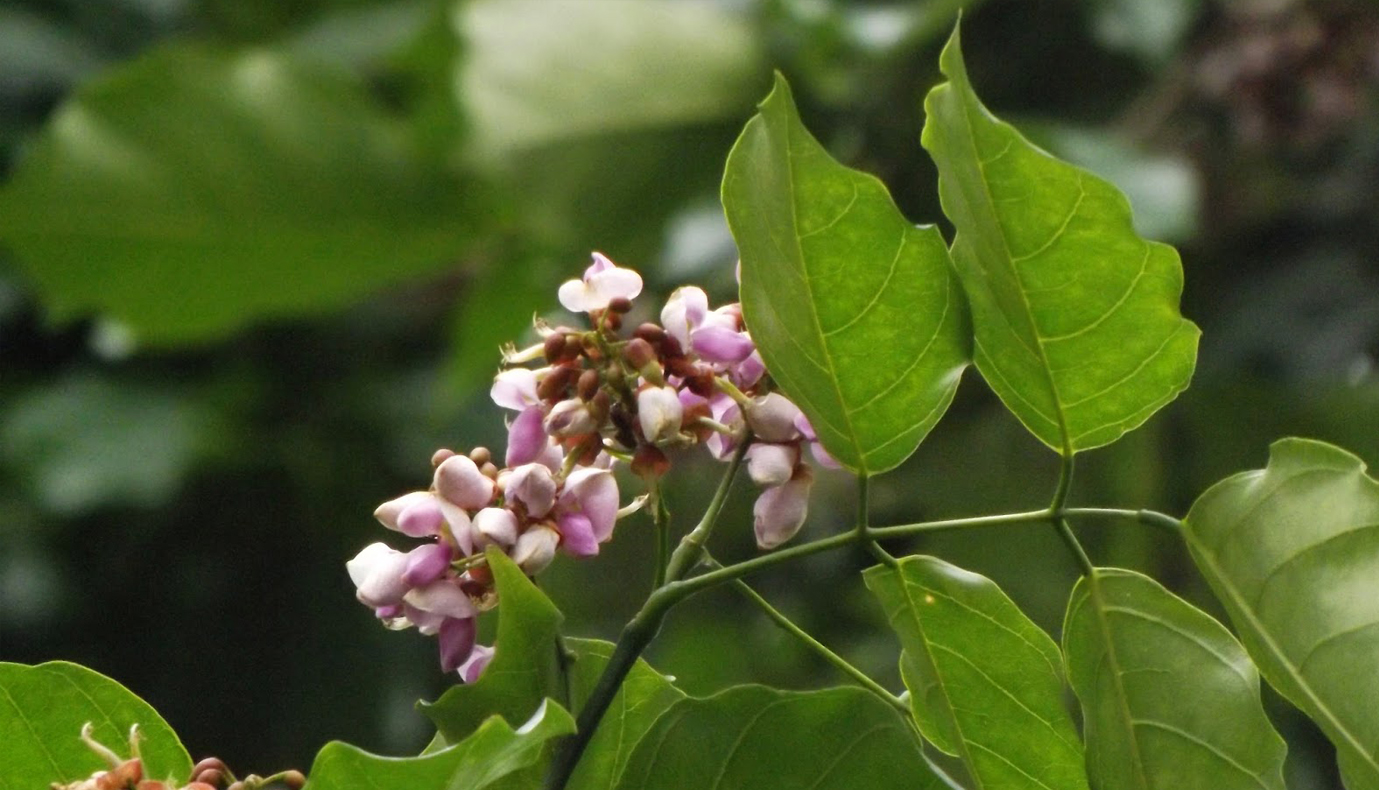
Botanical Name: Pithecellobium dulce (Roxb.) Benth
Kingdom: Plantae
Family: Fabaceae
Genus: Pongamia
Species:Pongamia pinnata
Location: Pongam tree is native to eastern and tropical Asia, Australia, and Pacific islands.
Description: It is a deciduous tree that grows to about 15-25 meters in height with a large canopy that spreads equally wide. The leaves are a soft, shiny burgundy in early summer and mature to a glossy, deep green as the season progresses. Small clusters of white, purple, and pink flowers blossom on their branches throughout the year, maturing into brown seed pods. The tree is well suited to intense heat and sunlight and its dense network of lateral roots and its thick, long taproot makes it drought tolerant. Flowering: March - April.
Medicinal Uses: Pongamia pinnata has been applied as a crude drug for the treatment of tumors, piles, skin diseases, and ulcers. The root is effective for treating gonorrhea, cleaning gums, teeth, and ulcers, and is used in vaginal and skin diseases. The seed oil is of various uses, especially for ulcers, rheumatism, leucoderma and scabies. In the Ayurvedic medicinal system, tribal people in southern India use this plant for the treatment of wounds.
References: Tropical Plants Database, Ken Fern. tropical.the ferns. info. 2022-03-13. Al Muqarrabun, L. M. R., Ahmat, N., Ruzaina, S. A. S., Ismail, N. H., & Sahidin, I. (2013). Medicinal uses, phytochemistry and pharmacology of Pongamia pinnata (L.) Pierre: A review. Journal of Ethnopharmacology, 150(2), 395-420.

Botanical Name: Prosopis cineraria
Kingdom: Plantae
Family: Fabaceae
Genus: Prosopis
Species:cineraria
Location: Prosopis cineraria, also known as ghaf, is a species of flowering tree in the pea family, Fabaceae. It is native to arid portions of Western Asia and the Indian Subcontinent, including Afghanistan, Bahrain, Iran, India, Oman, Pakistan, Saudi Arabia, the United Arab Emirates and Yemen.
Description: P. cineraria is a small tree, ranging in height from 3–5 m (9.8–16.4 ft). The leaves are bipinnate, with seven to fourteen leaflets on each of one to three pinnae. Branches are thorned along the internodes. Flowers are small and creamy-yellow, and followed by seeds in pods. The tree is found in extremely arid conditions, with rainfall as low as 15 cm (5.9 in) annually; but is indicative of the presence of a deep water table. As with some other Prosopis spp., P. cineraria has demonstrated a tolerance of highly alkaline and saline environments.
Medicinal Uses: Extract from unripe fruit pods of the plant was shown to ameliorate artificially-induced damage to testes in an animal model. Leaves of this tree can ameliorate mouth ulcers. By chewing it's leaves for few minutes and letting the juice of leaves in the mouth, remedies the ulcers. The swelling comes down significantly. Afterwards spit the juice out and brush ur teeth.
References: Dhananjaya Seturaman Prabha, Hans-Uwe Dahms, Prabha Malliga (2014), Pharmacological Potentials of phenolic compounds from Prosopis spp.- A Review, Journal of Coastal Life Medicine, Vol.2(11), Page no. 918-924. Indhiramuthu Jayashree, D H. Geetha and M. Rajeshwari (2014), Anti-Bacterial Properties of Prosopis cineraria (L.) Druce, International Journal of Advances in Pharmacy Biology and Chemistry, Vol. 3(3), Page no. 752. Khandelwal Preeti, Sharma Ram Avatar, Agarwal Mala (2015), Pharmacology, Phytochemistry and therapeutic application of Prosopis cineraria linn: A review, Journal of Plant Sciences, Vol. 3(1-1), Page No. 33-39.

Botanical Name: Punica granatum
Kingdom: Plantae
Family: Lythraceae
Genus: Punica
Species:granatum
Location: The pomegranate was originally described throughout the Mediterranean region. It was introduced into Spanish America in the late 16th century and into California by Spanish settlers in 1769. Pomegranates are widely cultivated throughout the Middle East and Caucasus region, north and tropical Africa, Iran, Armenia, the Indian subcontinent, Central Asia, the drier parts of Southeast Asia, and the Mediterranean Basin.
Description: A shrub or small tree growing 5 to 10 m (16 to 33 ft) high, the pomegranate has multiple spiny branches and is long-lived, with some specimens in France surviving for 200 years. P. granatum leaves are opposite or subopposite, glossy, narrow oblong, entire, 3–7 cm (1+1⁄4–2+3⁄4 in) long and 2 cm (3⁄4 in) broad. The flowers are bright red and 3 cm (1+1⁄4 in) in diameter, with three to seven petals. Some fruitless varieties are grown for the flowers alone.
Medicinal Uses: Punica granatum L. (pomegranate) has several health benefits. Pomegranates can help prevent or treat various disease risk factors including high blood pressure, high cholesterol, oxidative stress, hyperglycemia, and inflammatory activities.
References: Das AK, Mandal SC, Banerjee SK, Sinha S, Das J, Saha BP, Pal M: Studies on antidiarrheal activity of Punica granatum seed extract in rats. Journal of Ethnopharmacology 1999; 68: 205-208. Jafri MA, Aslam M, Javed K, Singh S: Effect of Punica granatum Linn. (flowers) on blood glucose level in normal and alloxan induced diabetic rats.Journal of Ethnopharmacology 2000; 70: 309-314. Satomi H, Umemura K, Ueno A, Hatano T, Okuda T, Noro T: Carbonic anhydrase inhibitors from the pericarps of Punica granatum L. Biol Pharm Bull. 1993; 16:787-90.
 O.F.jpg)
Botanical Name: Pithecellobium dulce (Roxb.) Benth
Kingdom: Plantae
Family: Arecaceae
Genus: Roystonea
Species:Roystonea regia
Location: Roystonea is found in Central America, Cuba, the Cayman Islands, Hispaniola (the Dominican Republic and Haiti), the lesser Antilles, The Bahamas, Southern Florida, and Mexico (Veracruz, Campeche, Quintana Roo, Yucatan).
Description: Roystonea regia is a large palm which reaches a height of 20-30 meters (66-98ft) Tall. The trunk is stout, very smooth and grey white in color. Trees have about 15 leaves which can be up to 4m (13ft) Long. The flowers are white with pinkish anthers. The fruits are spheroid to ellipsoid in shape, 8.9-15 millimeters (0.35-0.59)in long and 7-10.9mm (0.28-0.43)in wide. They are green when immature, turning red and eventually purplish black as they mature.
Medicinal Uses: It is widely planted as an ornamental. R. Regia is also used for thatch, construction timber, and in some forms of so-called traditional medicine, although there is currently no valid scientific evidence to support the efficacy or use of any palm species for medicinal purposes.
References: Carrero, c (2021)” Roystonea regia”IUCN Red List of threatened species 2021 Cuban Royal Palm (Roystonea regia), Retrieved 2009-04-21
https://en.m.wikipedia.org
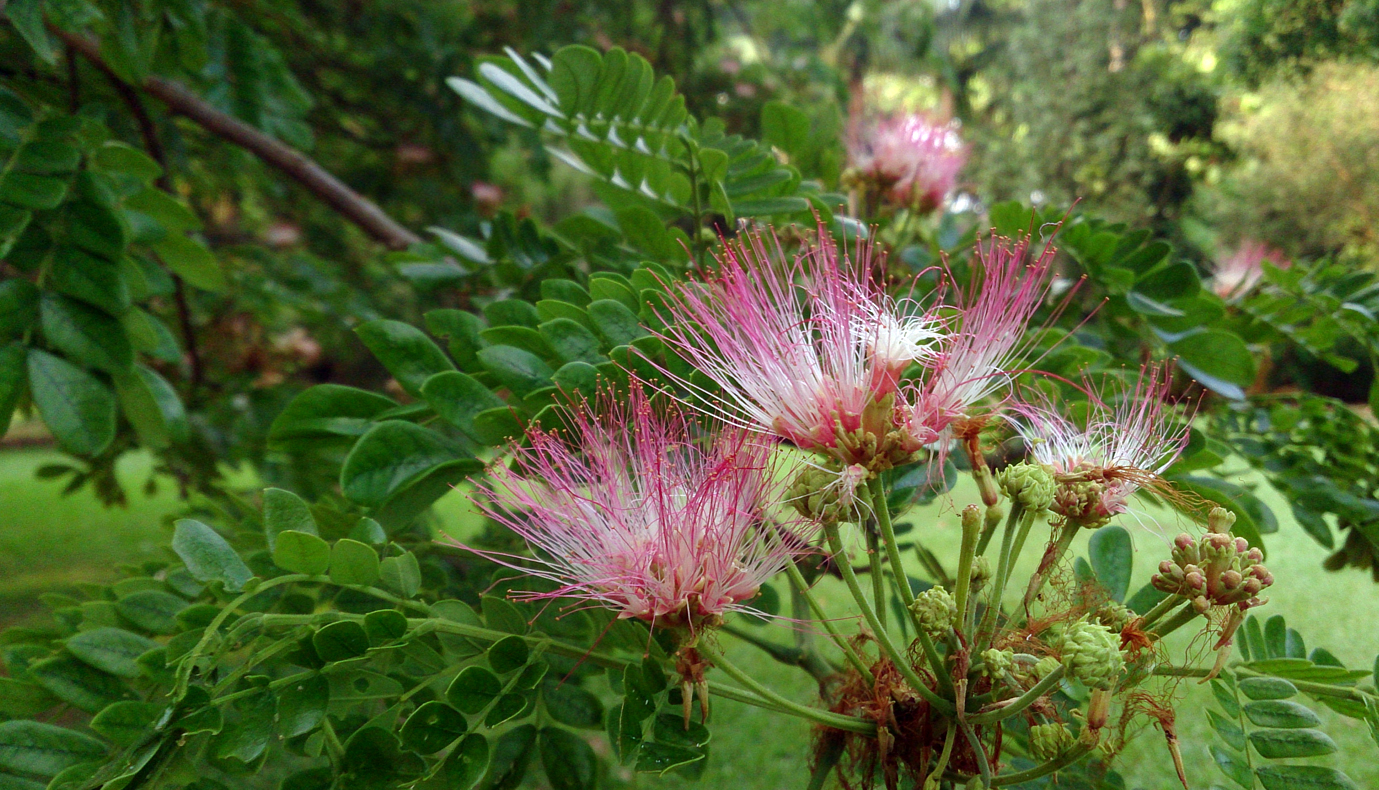
Botanical Name: Samanea saman (Jacq.) Merr.
Kingdom: Plantae
Family: Fabaceae
Genus: Samanea
Species:S. saman
Location: Its range extends from Mexico south to Peru and Brazil, but it has been widely introduced to South and Southeast Asia as well as the Pacific Islands, including Hawaii, common names include saman, rain tree and monkey pod.
Description: Saman is a wide-canopied tree with a large symmetrical umbrella – shaped crown. It usually reaches a height of 15-25 m (49-82ft) and a diameter of 30 m (98 ft).The leaves fold in rainy weather and in the evening, hence the names rain tree and five o clock tree (Pukul Lima in Malay). The tree has pinkish flowers with white and red stamens, set on heads with around 12-25 flowers per head. These heads may number in the thousands, covering the whole tree. The seed pods of the tree contain sticky, edible flesh.
Medicinal Uses: It is a folk medicine used as the remedy for headache, cold, diarrhea, stomach – ache intestinal ailments, sore throat, and stomach cancer. The boiled bark is used as a bandage to cure constipation. The decoction of bark (inner) and leaves is used for diarrhea.
References: ARDITTI, - JOSEPH ON, MAK CHIN (2004) The Golden Rain Tree version of 2004-May – 01 Retrieved 2008-March – https //www.fulltxt.org
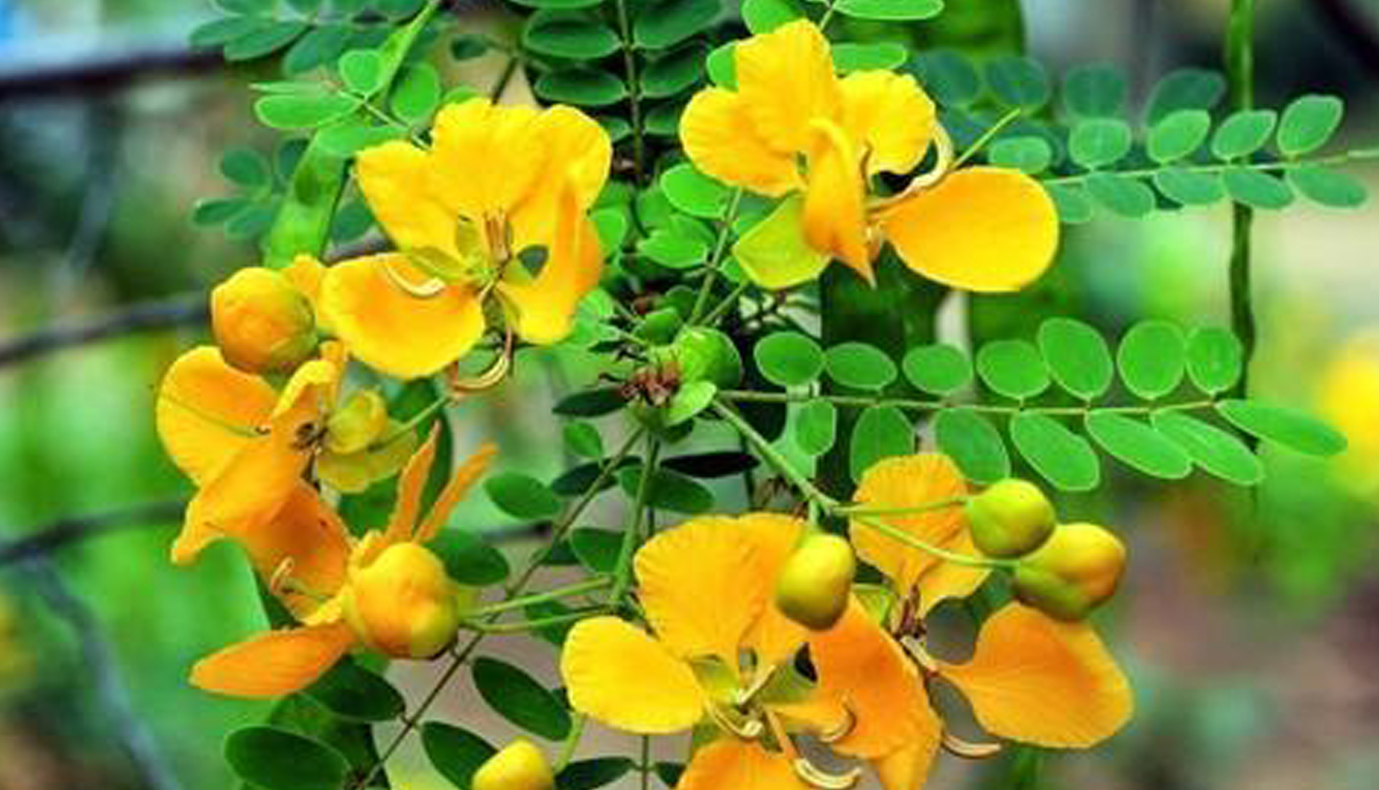
Botanical Name: Senna auriculata
Kingdom: Plantae
Family: Fabaceae
Genus: Senna
Species:S.auriculata
Location: It is found in the dry regions of India and Srilanka. It is common along the sea coast and the dry zone in Sri Lanka.
Description: Avaram senna is a much branched shrub with smooth cinnamon brown bark and closely pubescent branchlets. The leaves are alternate, stipulate, paripinnate compound, very numerous, closely placed, rachis 8.8-12.5 cm long, narrowly furrowed, slender, pubescent, with an erect linear gland between the leaflets of each pair, leaflets 16-24, very shortly stalked 2-2.5 cm long 1-1.3 cm broad, slightly overlapping, oval oblong, obtuse, at both ends, dull green, paler beneath, stipules very large, reniform-rotund, produced at base on side of next petiole into a fili-form point and persistent. Its flowers are irregular, bisexual, bright yellow and large (nearly 5 cm across), the pedicels glabrous and 2.5 cm long. The fruit is a short legume.
Medicinal Uses: It is for diabetes, pink eye, joint and muscle pain (rheumatism), constipation, and other conditions. The root is used in decoctions against fevers, diabetes, diseases of urinary system and constipation. The dried flowers and flower buds are used as a substitute for tea in case of diabetes patients. The powdered seed is also applied to the eye, in case of chronic purulent conjunctivitis. In Africa the bark and seeds are said to give relief in rheumatism, eye diseases, gonorrhea, diabetes and gout.
References: https://en.wikipedia.org/wiki/Senna_auriculata
https://www.webmd.com/vitamins/ai/ingredientmono-1094/cassia-auriculata#:~:text=Cassia%20auriculata%20is%20an%20evergreen,treatment%2C%20especially%20in%20Ayurvedic%20medicine>
https://en.wikipedia.org/wiki/Senna_auriculata
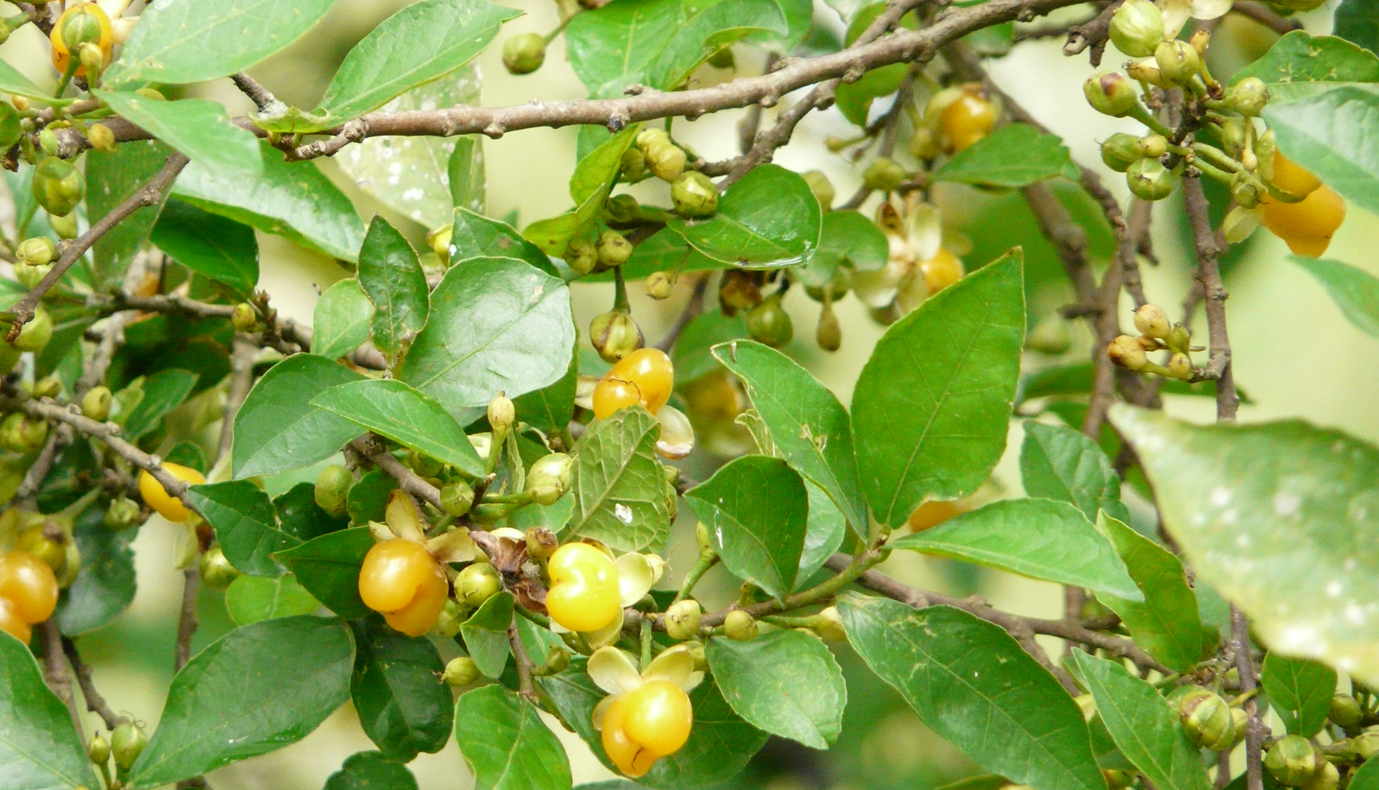
Botanical Name: Streblus asper lour
Kingdom: Plantae
Family: Moraceae
Genus: Streblus
Species:S.asper
Location: It is found in dry regions in Indonesia, Cambodia, Thailand, India, Sri Lanka, Malaysia, and Vietnam.
Description: It is a small, rigid, evergreen tree with latex and grows upto 15 meter in height. Twigs are hairy and interwoven. Bark is rough grey to greenish in color. Leaves are simple, alternate, rhomboid, elliptic, acute or acuminate more or less crenate-scabrid on both surfaces.
Medicinal Uses: The root is prescribed as a cure for elephantiasis. Roots are astringent, bitter, acrid, anti-inflammatory, healing, haemostatic, febrifuge and antiseptic. They are useful against vitiated conditions of kapha, ulcers, sinusitis, elephantiasis, boils, haemorrhage, bronchitis, diarrhoea, dysentery, syphilis and hemorrhoids. The bark is used for constipation and ulcers.
References:
https://indiabiodiversity.org/species/show/231242
https://vikaspedia.in/agriculture/crop-production/package-of-practices/medicinal-and-aromatic-plants/streblus-asper
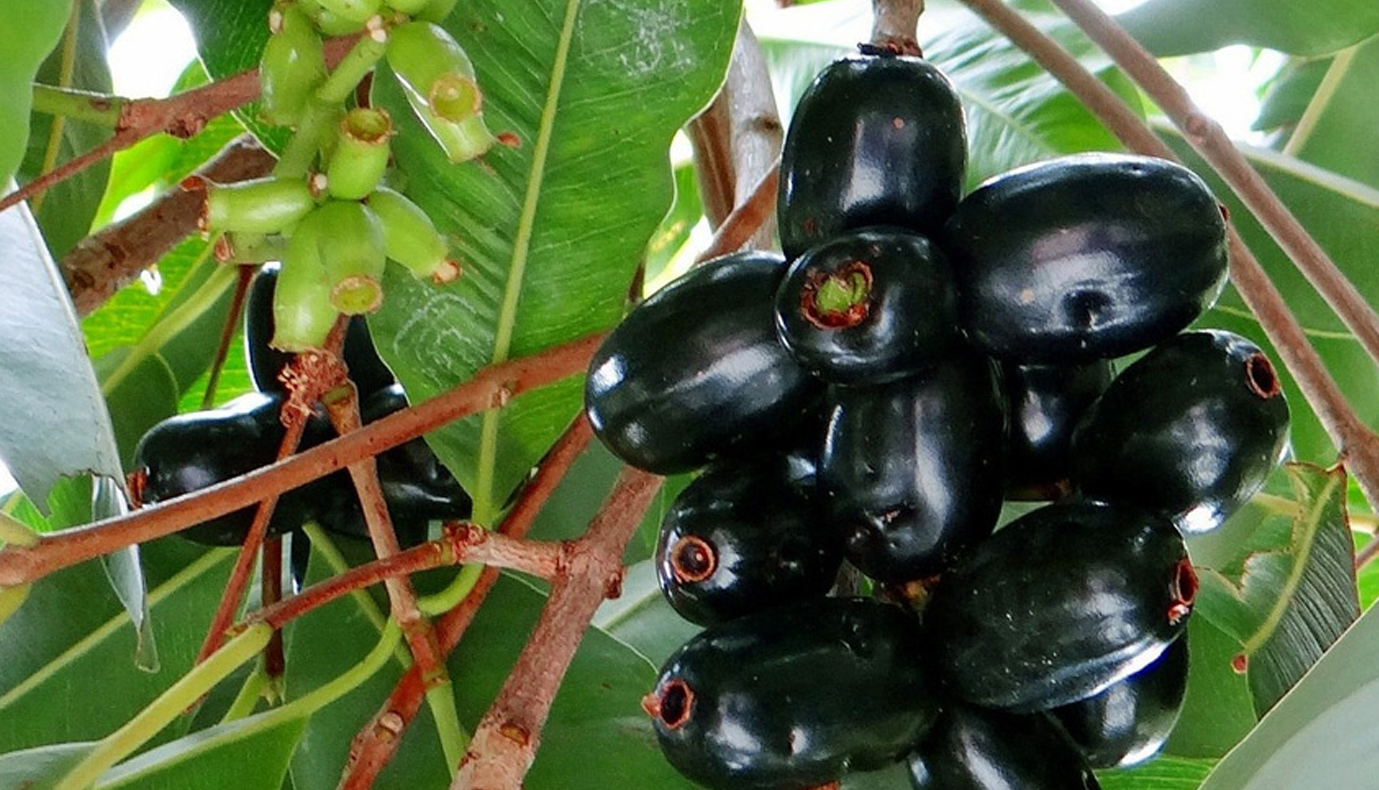
Botanical Name: Syzygium cumini (L.) Skeels
Kingdom: Plantae
Family: Myrtaceae
Genus: Syzygium
Species:S. cumini (L.) Skeels
Location: Java plum is widely grown in the South Asia. They are native to Indonesia, India, Myanmar, Sri Lanka, China and Malaysia.
Description: As a rapidly growing species, it can reach heights of up to 30 m (100 ft) and can live more than 100 years.Syzygium cumini trees start flowering from March to April. The flowers are fragrant and small, about 5 mm (0.2 in) in diameter. The fruits develop by May or June and resemble large berries; the fruit of Syzygium species is described as "drupaceous”. The fruit is oblong, ovoid. Unripe fruit looks green. As it matures, its colour changes to pink, then to shining crimson red and finally to black colour.
Medicinal Uses: Jamun fruits, leaves, seeds, and bark are used as ayurvedic medicine. The Jamun fruit extract is used in treating the common cold, cough, and flu.The Jamun seeds are used in treatment of Diabetes, allergies, viral infection, inflammation and gastric ulcer. It also has diuretic, anti-nociceptive, hypothermic, chemoprotective and cardioprotective effect.Improves haemoglobin count. Loaded with vitamin C and iron, jamun increases haemoglobin. Jamun has astringent property. It improves health of skin and eyes. It keeps your heart healthy. It strengthens your gums and teeth. It prevents infection. It treats diabetes. A dialysis patient can freely consume 5-6 pieces of Jamun. 100g of the fruit contains 79mg of Potassium making it absolutely kidney friendly fruit.
References: Julia F Morton (1987). "Jambolan, Syzygium cumini Skeels". In: Fruits of Warm Climates, p. 375–378; NewCROP, New Crop Resource Online Program, Center for New Crops and Plant Products, Purdue University. Retrieved 3 July 2020. https://www.india.com/lifestyle/health-benefits-of-jamun-7-amazing-benefits-of-eating-black-plum-2570661/
https://pharmeasy.in/blog/jamun-benefits-uses-side-effects/

Botanical Name: Tabebuia rosea
Kingdom: Plantae
Family: Bignoniaceae
Genus: Tabebuia
Species:rosea
Location: This species is distributed from southern México, to Venezuela and Ecuador. It has been found growing from sealevel to 1,200 m (3,937 ft), in temperatures ranging from 20 °C to 30 °C on average, with annual rainfall above 500 mm, and on soils with very variable pH.
Description: The tree is short length, with irregular, stratified ramification and only few thick branches. The bark can be gray to brown, in varying darkness and may be vertically fissured. Leaves are compound, digitate and deciduous. Each leaf has five leaflets of variable size, the middle one being the largest. Flowering occurs mainly in January and February, and is generally associated with dry periods; although flowering has also been observed in August, September, April and May. Flowers are large, in various tones of pink to purple, and appear while the tree has none, or very few, leaves. Pollination occurs probably by insects, although the flowers are visited by many birds such as tanagers, hummingbirds and orioles. The long and slender fruit capsules can measure up to 35 cm (14 in) and appear from February through April. After the drying fruit dehisces, the anemochorous, hyaline-membrane-winged seeds are released. There are an average of 45,000 seeds per kg with up to 13% water content. Germination of seeds is extremely easy and efficient, reaching almost 100%.
Medicinal Uses: Preparations of the bark of the tree are consumed to eliminate intestinal parasites, malaria and uterine cancer. A decoction of the bark is recommended for anemia and constipation. A decoction of the flowers, leaves and roots has been used to reduce fevers and pain, cause sweating, to treat tonsil inflammation and various other disorders. Among the various active phytochemicals in the tree is lapachol, a natural organic compound isolated from various other Tabebuia species. Chemically, it is a derivative of naphthoquinone, related to vitamin K.
References: Oloyede G.K, Oladosu I.A, Shodia A.F andOloyade O.O., Cytotoxic Effects of TabebuiaRosea Oils (Leaf and Stem Bark), Archives ofApplied Science Research., 2010, 2 (3), 127-130. Sathya M and Muthuchelian K., Studies onPhytochemical Profile and Antibacterial Activityof Ethanolic Leaf Extract of Tabebuia rosea(Bertol.) DC, Ethnobotanical Leaflets., 2008, 12,1153-57. Sathya M and Muthuchelian K., AntitumorPotent ial of Total Alkaloid Extract fromTabebuia rosea (Bertol.) DC. Leaves on MOLT-4 Cells In Vitro, Nature and Science.,2010,8(9), 77-85.

Botanical Name: Tamarindus indica
Kingdom: Plantae
Family: Fabaceae
Genus: Tamarindus
Species:T.indica
Location: It is native to eastern Africa, but is now commonly grown and in some cases has naturalized in a number of tropical to subtropical areas around the world.
Description: Tamarindus indica is a tree up to 30 m tall with a spreading crown of up to 12m in diameter. The leaves are up to 15 cm long and are composed of numerous small leaflets arrange in pairs along a central axis. The flowers are about 2.5cm across and have three petals that are golden with a pattern of red veins as well as two tiny thread-like petals that are barely visible. The brown, short-haired, sausage-like fruits contain an acidic pulp.
Medicinal Uses: The whole plant parts have rich nutritional value and wide usage in medicine. In traditional medicine it is used in wound healing, abdominal pain, diarrhoea, dysentery, parasitic infestations, constipation and inflammation. It is rich source of most of the essential amino acid and phytochemical, and hence the plant is reported to possess antidiabetic, antimicrobial, antivenomic, antioxidant, antimalarial, cardioprotective, hepatoprotective, antiasthmatic, laxative and antihyperlipidemic activity
References: https://en.m.wikipedia.org/wiki/Tamarind
https://powo.science.kew.org/taxon/urn:lsid:ipni.org:names:520167-1
https://www.sciencedirect.com/science/article/pii/S2221169115300885
 Juss. ex Kunth.jpg)
Botanical Name: Tecoma stans (L.) Juss. ex Kunth
Kingdom: Plantae
Family: Bignoniaceae
Genus: Tecoma
Species:Tecoma stans
Location: Tecoma stans is native to the Americas. It extends from the southern United States through Mexico, Central America, and the Antilles to northern Venezuela.
Description: Tecoma stans is a large shrub or small, much branched tree, growing up to 1-8 m tall. The younger stems are smooth, hairless and 4-angled in cross-section, greenish, then pale- or reddish brown. The bark on the main stem is light brown to pale grey, furrowed and with relatively rough texture. Borne on slender stalks, the leaves are opposite and compound with 3-13 leaflets. The leaflets are elongated or narrowly egg-shaped with a broad base, a pointed tip and sharply toothed margins, mostly hairless, bright green above, paler below. Bright yellow, showy, trumpet-shaped flowers appear in terminal clusters from October to May. The fruits are large and flattened linear capsules, brown when mature, and splitting open to release numerous papery winged seeds.
Medicinal Uses: Tecoma stans is a herbal medicine used for treatment of diabetes, digestive problems, control of yeast infections, as powerful diuretic, vermifuge and tonic. Preliminary phytochemical screening of this plant revealed the presence of tannins, flavonoids, alkaloids, quinones and traces of saponins and amino acids.
References: http://publish.plantnet-project.org/project/plantinvasivekruger/collection/collection/synthese/details/TECST
http://pharmaerudition.org/ContentPaper/2013/3(2)13-21.pdf
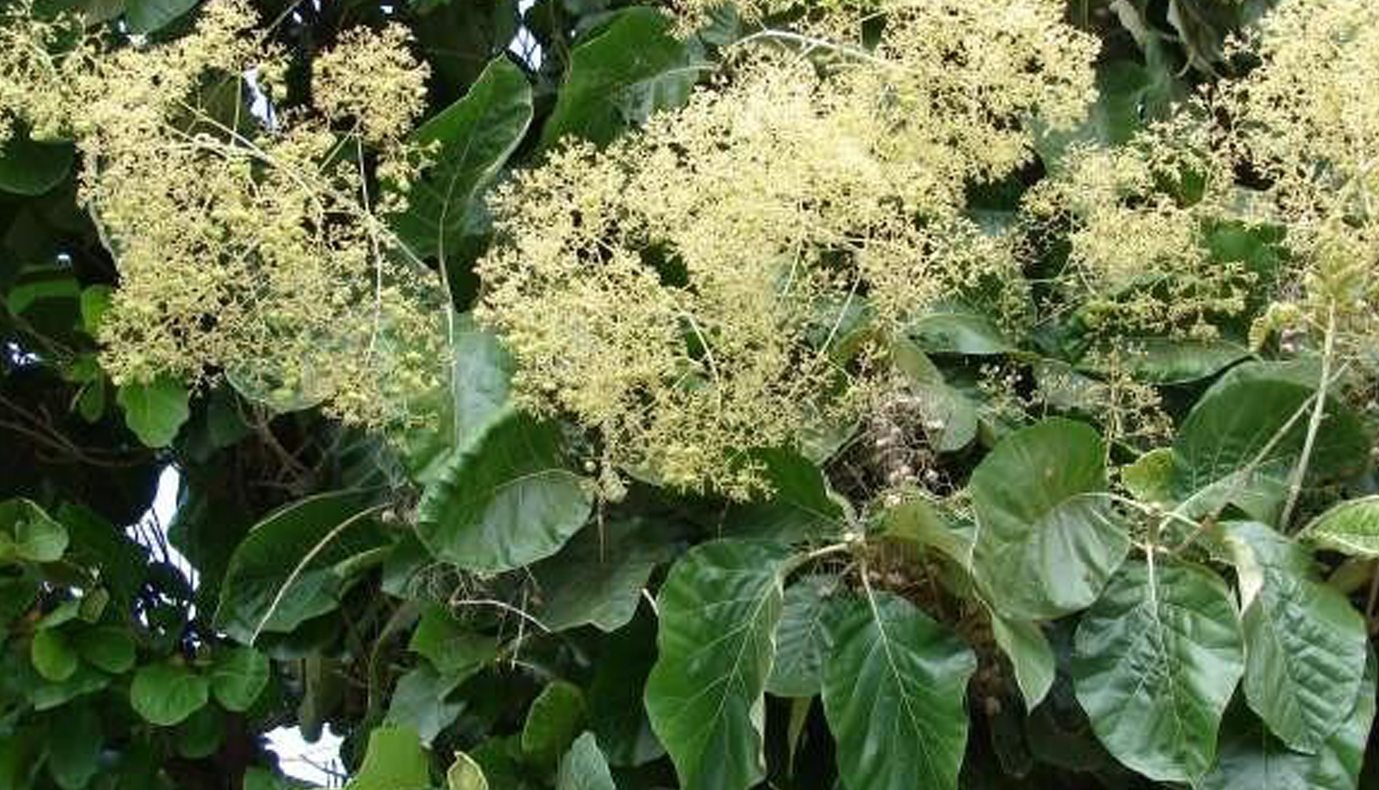
Botanical Name: Tectona grandis
Kingdom: Plantae
Family: Lamiaceae
Genus: Tectona
Species: T.grandis
Location: Tectona grandis is native to south and Southeast Asia, mainly Bangladesh, India, Indonesia, Malaysia, Myanmar, Thailand and Sri Lanka, but is naturalized and cultivated in many countries in Africa and the Caribbean.
Description: It is a large, deciduous tree that occurs in mixed hardwood forests. Tectona grandis has small, fragrant white flowers arranged in dense clusters (panicles) at the end of the branches.
Medicinal Uses: According to Ayurveda, wood is acrid, cooling, laxative, sedative to gravid uterus and useful in treatment of piles, leucoderma and dysentery. Flowers are acrid, bitter and dry and useful in bronchitis, biliousness, urinary discharges etc.
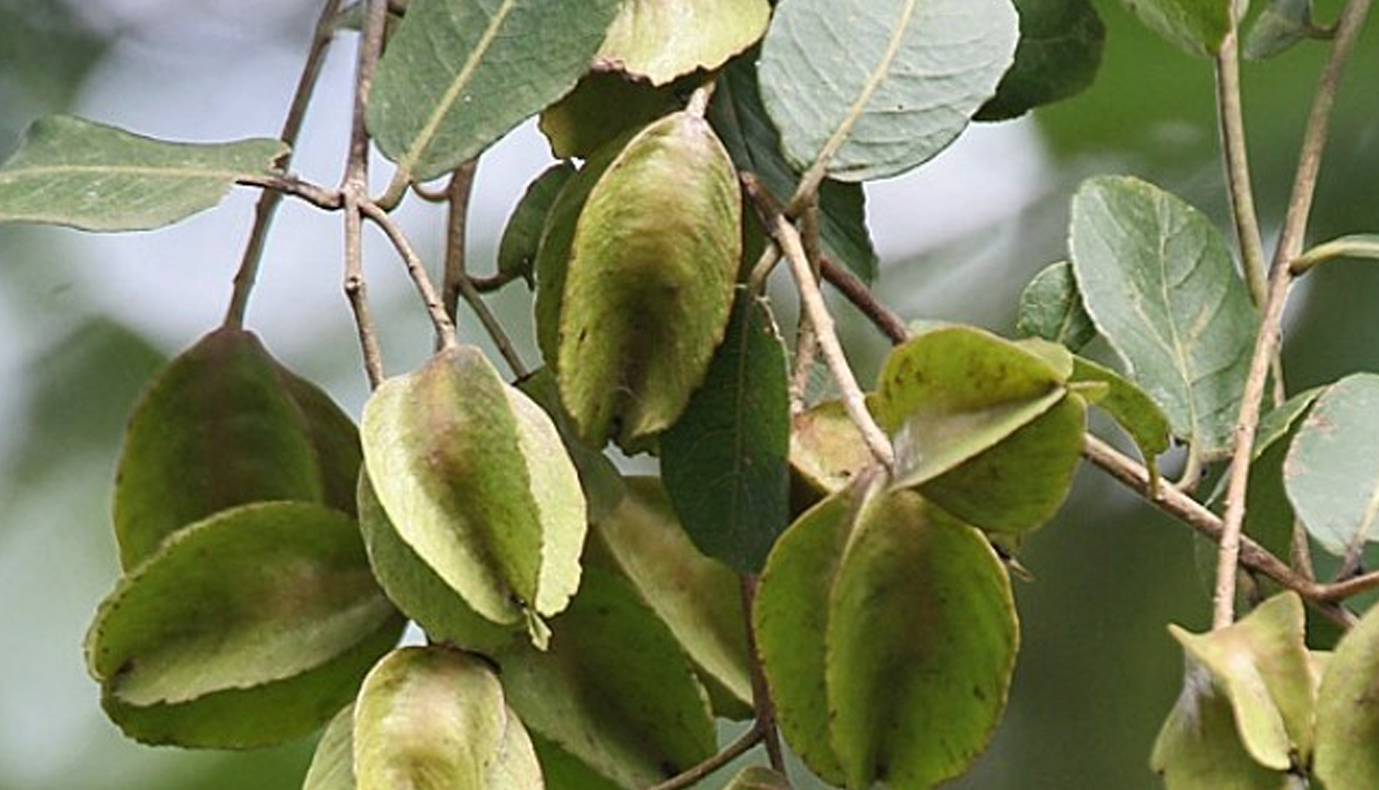
Botanical Name: Terminalia arjuna (Roxb. ex DC.) Wight &Arn.
Kingdom: Plantae
Family: Combretaceae
Genus: Terminalia
Species: Terminalia arjuna
Location: Arjun tree is widely grown in India, Srilanka, Bangladesh, etc.
Description: It is commonly known as arjuna or arjun tree in English. T. arjuna grows to about 20–25 metres tall; usually has a buttressed trunk, and forms a wide canopy at the crown, from which branches drop downwards. It has oblong, conical leaves which are green on the top and brown below; smooth, grey bark; it has pale yellow flowers which appear between March and June; its glabrous, 2.5 to 5 cm fibrous woody fruit, divided into five wings, appears between September and November.
Medicinal Uses: In traditional Ayurvedic medicine, Terminalia arjuna has been used to balance the three “humors”: kapha, pitta, and vata. It has also been used for asthma, bile duct disorders, scorpion stings, and poisonings. The bark of Terminalia arjuna has been used in India for more than 3000 years, primarily as a heart remedy.Terminalia is most commonly used for heart ailments including heart failure and chest pain. It is also used for diabetes, high cholesterol, and many other conditions, but there is no good scientific evidence to support these uses.
References: https://www.emedicinehealth.com/terminalia/vitamins-supplements.htm
https://www.webmd.com/vitamins/ai/ingredientmono-811/terminalia

Botanical Name: Terminalia bellirica (Gaertn.) Roxb.
Kingdom: Plantae
Family: Combretaceae
Genus: Terminalia
Species: Terminalia bellirica
Location: It is widely found in Pakistan, Uzbekistan, Sri Lanka, Southeast Asia, China and Malaysia. Terminalia bellirica is native to tropical Asia. It has been successfully grown at low altitudes in Mauritius, but because of its sensitivity to wood borer infestation, it is no longer planted.
Description: Terminalia bellirica is a huge deciduous tree with a rounded crown that can grow up to 50metres tall and a diameter of 3metres. up to 20metres, the regularly buttressed bole at the base is branchless. The inner bark is yellowish while the outer bark is bluish or ashy-grey with numerous fine longitudinal fissures.
Medicinal Uses: In traditional Ayurvedic medicine beleric is known as “Bibhitaki”. Its fruit is used as a popular Indian herbal traditional rasayana treatment triphala. Terminalia bellirica is used to treat respiratory disease such as respiratory tract infections, cough, and sore throat as well as to protect the liver. For sore eyes, Terminalia bellirica are used as a lotion.
References: https://www.rxlist.com/terminalia/supplements.htm
https://en.m.wikipedia.org/wiki/Terminalia_bellirica
https://www.sciencedirect.com/topics/agricultural-and-biological-sciences/myrobalans

Botanical Name: Terminalia catappa
Kingdom: Plantae
Family: Combretaceae
Genus: Terminalia
Species: T.catappa
Location: Terminalia catappa native to the Indo-Malayan region is widespread in tropico-equatorial regions. Terminalia catappa is a native plant of Asia that has escaped from cultivation. Due to its ability to cope with sandy, well draining soil and salt spray it is often found on coastal regions.
Description: Terminalia catappa is a large tropical tree in the lead wood tree family, Combretaceae , native to Asia , Australia , the Pacific and Madagascar . Common names in English include country almond , Indian almond , Malabar almond , sea almond , Tropical almond , beach almond and false kamani. The tree grows to 35m (115ft) tall, with an upright, symmetrical crown and horizontal branches. Terminalia catappa has corky, light fruit that are dispersed by water. The seed within the fruit is edible when fully ripe, tasting almost like almond. As the tree gets older, its crown becomes more flattened to form a spreading, vase shape. Its branches are distinctively arranged in tiers. The leaves are large, 15-25cm (5.9-9.8 in) long and 10-14cm (3.9-5.5 in) broad, ovoid, glossy dark green and leathery. They are dry-season deciduous. Before falling, they turn pinkish-reddish or yellow-brown, due to pigments such as violaxanthin, lutein and zeaxanthin.
Medicinal Uses: It can be used topically – to dry out oozing wounds (burns, tropical ulcers, mycosis of folds), to clean soiled wounds (in the absence of other antiseptics), in mouth wash (mouth ulcer, mouth sore), by diluting a little this decoction, in a siege bath (hemorrhoids, genital leaning, vulvo vaginitis) . Orally, to calm diarrhea and vomiting without fever, for example: in case of ciguatera (intoxication by the flesh of the coral fish):1/2 glass to 1 glass 1-3 times a day according to the intensity of the symptoms. T. catappa leaves are used to treat scabies, leprosy wounds and other skin diseases. Its traditional use includes the treatment of diarrhea and fever, especially in India, the Philippines and Malaysia. The leaves are, emollients-the juice of slightly heated leaves can be applied to boils or abscesses to ripen them, and astringent-yellowened leaf juice diluted in gargle water in case of angina, tonsillitis.
References: Https://www.itis.gov
Https://www.phytomania.com
Https://tropical.theferns.info
Https://www.frontiersin.org

Botanical Name: Thespesia populnea
Kingdom: Plantae
Family: Malvaceae
Genus: Thespesia populnea
Species: T.populnea
Location: It is a tree found commonly on coasts around the world. It was introduced to the Pacific Islands from Island Southeast Asia.
Description: The Portia tree reaches a height of 6–10 m (20–33 ft) tall and its trunk can measure up to 20–30 cm (7.9–11.8 in) in diameter. It grows at elevations from sea level to 275 m (902 ft) in areas that receive 500–1,600 mm (20–63 in) of annual rainfall. The Portia tree is able to grow in the wide range of soil types that may be present in coastal environments.
Medicinal Uses: Traditionally it was planted in sacred groves and used for religious sculpture throughout eastern Polynesia. In Tahiti, Milo wood is used in the making of the to'ere (slotted wooden drum), used in traditional Tahitian tribal drumming. Makoʻi was used for the rongorongo tablets of Easter Island. Since the advent of aluminium-hulled boats in the 20th century, Pitcairners have made regular trips to Henderson Island to harvest miro wood.
References:https://en.wikipedia.org/wiki/Thespesia_populnea#Uses
https://en.wikipedia.org/wiki/Thespesia_populnea#Description